-
Notifications
You must be signed in to change notification settings - Fork 125
threading.scad
Provides generic threading support and specialized support for standard triangular (UTS/ISO) threading, trapezoidal threading (ACME), pipe threading, buttress threading, square threading and ball screws.
To use, add the following lines to the beginning of your file:
include <BOSL2/std.scad>
include <BOSL2/threading.scad>
-
Section: Standard (UTS/ISO) Threading
-
threaded_rod()– Creates an UTS/ISO triangular threaded rod. [Geom] -
threaded_nut()– Creates an UTS/ISO triangular threaded nut. [Geom]
-
-
Section: Trapezoidal Threading
-
trapezoidal_threaded_rod()– Creates a trapezoidal threaded rod. [Geom] -
trapezoidal_threaded_nut()– Creates a trapezoidal threaded nut. [Geom] -
acme_threaded_rod()– Creates an ACME threaded rod. [Geom] -
acme_threaded_nut()– Creates an ACME threaded nut. [Geom]
-
-
-
npt_threaded_rod()– Creates NPT pipe threading. [Geom]
-
-
-
buttress_threaded_rod()– Creates a buttress-threaded rod. [Geom] -
buttress_threaded_nut()– Creates a buttress-threaded nut. [Geom]
-
-
-
square_threaded_rod()– Creates a square-threaded rod. [Geom] -
square_threaded_nut()– Creates a square-threaded nut. [Geom]
-
-
-
ball_screw_rod()– Creates a ball screw rod. [Geom]
-
-
-
generic_threaded_rod()– Creates a generic threaded rod. [Geom] -
generic_threaded_nut()– Creates a generic threaded nut. [Geom] -
thread_helix()– Creates a thread helix to add to a cylinder. [Geom]
-
A standard process for making machine screws is to begin with round stock that has beveled ends. This stock is then rolled between flat, grooved plates to form the threads. The result is a bolt that looks like this at the end:
Figure 1.1:
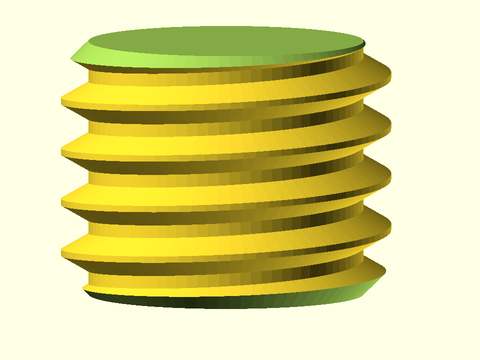
Figure 1.2: A properly mated screw and bolt with beveled ends
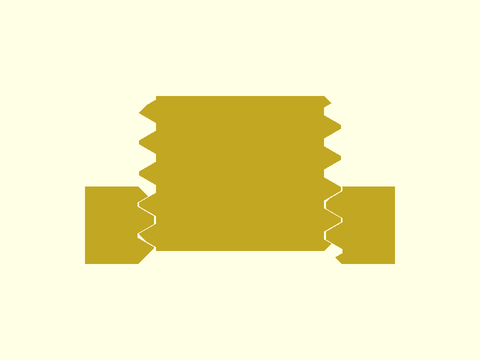
Cross threading occurs when the bolt is misaligned with the threads in the nut. It can destroy the threads, or cause the nut to jam. The standard beveled end process makes cross threading a possibility because the beveled partial threads can pass each other when the screw enters the nut.
Figure 1.3:
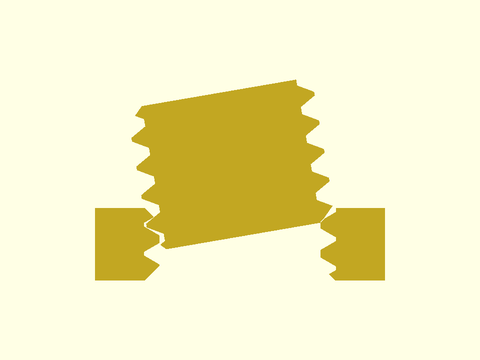
In addition, those partial screw threads may be weak, and easily broken. They do not contribute to the strength of the assembly. In 1891 Clinton A. Higbee received a patent for a modification to screw threads https://patents.google.com/patent/US447775A meant to address these limitations. Instead of beveling the end of the screw, Higbee said to remove the partial thread. The resulting screw might look like this:
Figure 1.4:
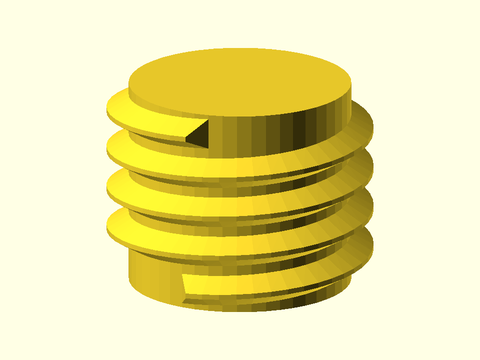
Because the threads are complete everywhere, cross threading is unlikely to occur.
This type of threading has been called "Higbee threads", but in recent machinist
handbooks it is called "blunt start" threading.
This style of thread is not commonly used in metal fasteners because it requires
machining the threads, which is much more costly than the rolling procedure described
above. However, plastic threads usually have some sort of gradual thread end.
For models that will be 3D printed, there is no reason to choose the standard
bevel end bolt, so in this library the blunt start threads are the default.
If you need standard bevel-end threads, you can choose them with the blunt_start options.
Note that blunt start threads are more efficient.
Various options exist for controlling the ends of threads. You can specify bevels on threaded rods.
In conventional threading, bevels are needed on the ends to remove sharp, thin edges, and
the bevel is sized to the full outer diameter of the threaded rod.
With blunt start threading, the bevel appears on the unthreaded part of the rod.
On a threaded rod, a bevel value of true or a positive bevel value cut off the corner.
Figure 1.5:
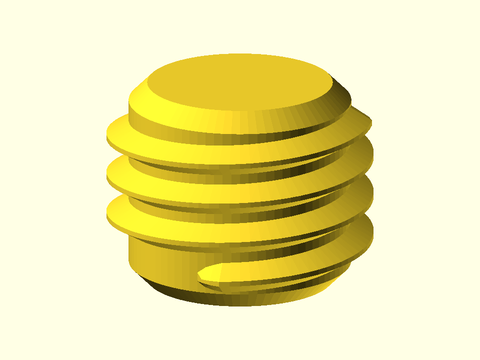
A negative bevel value produces a flaring bevel, that might be useful if the rod needs to mate with another part.
You can also set bevel="reverse" to get a flaring bevel of the default size.
Figure 1.6: Negative bevel on a regular threaded rod.
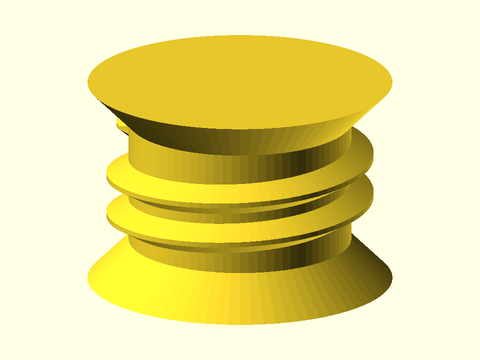
If you set internal=true to create a mask for a threaded hole, then bevels are reversed: positive bevels flare outward so that when you subtract
the threaded rod it gives a beveled edge to the hole. In this case, negative bevels go inward, which might be useful to
create a bevel at the bottom of a threaded hole.
Figure 1.7: Threaded rod mask produced using internal=true with regular bevel at the top and reversed bevel at the bottom.
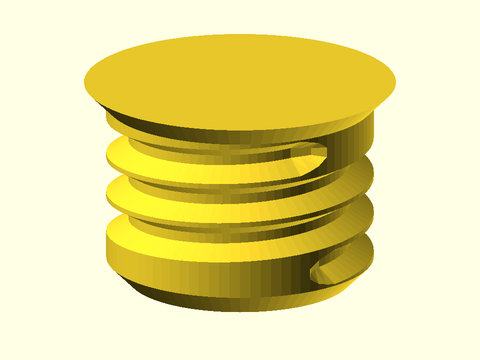
You can also extend the unthreaded section using the end_len parameters. A long unthreaded section will make
it impossible to tilt the bolt and produce misaligned threads, so it could make assembly easier.
Figure 1.8: Negative bevel on a regular threaded rod.
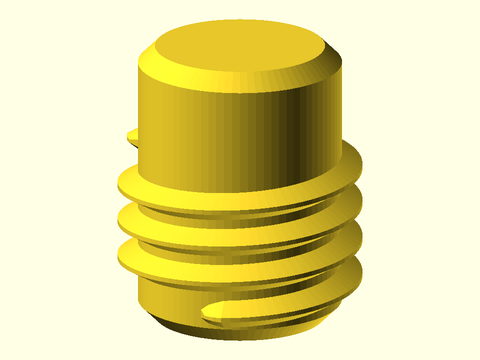
It is also possible to adjust the length of the lead-in section of threads, or the
shape of that lead-in section. The lead-in length can be set using the lead_in arguments
to specify a length or the lead_in_ang arguments to specify an angle. For general
threading applications, making the lead in long creates a smaller thread that could
be more fragile and more prone to cross threading.
Figure 1.9:

To change the form of the thread end you use the lead_in_shape argument.
You can specify "sqrt", "cut" or "smooth" shapes. The "sqrt" shape is the historical
shape used in the library. The "cut" shape is available to model Higbee pattern threads, but
is not as good as the others in practice, because the flat faces on the threads can hit each other.
The lead-in shape is produced by applying a scale factor to the thread cross section that varies along the lead-in length.
You can also specify a custom shape
by giving a function literal, f(x,L) where L will be the total linear
length of the lead-in section and x will be a value between 0 and 1 giving
the position in the lead in, with 0 being the tip and 1 being the full height thread.
The return value must be a 2-vector giving the thread width scale and thread height
scale at that location. If x<0 the function must return a thread height scale
of zero, but it is usually best if the thread width scale does not go to zero,
because that will give a sharply pointed thread end. If x>1 the function must
return [1,1].
Figure 1.10: The standard lead in shapes
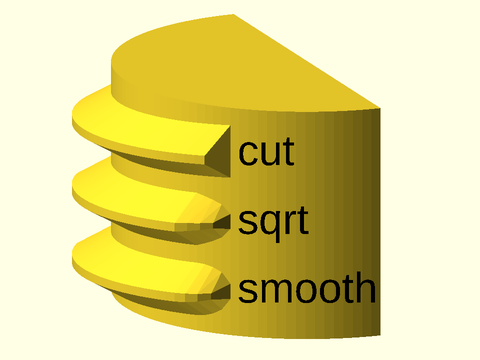
Synopsis: Creates an UTS/ISO triangular threaded rod. [Geom]
See Also: threaded_nut()
Usage:
- threaded_rod(d, l|length, pitch, [internal=], ...) [ATTACHMENTS];
Description:
Constructs a standard ISO (metric) or UTS (English) threaded rod. These threads are close to triangular, with a 60 degree thread angle. You can give diameter value which specifies the outer diameter and will produce the "basic form" or you can set d to a triplet [d_min, d_pitch, d_major] where are parameters determined by the ISO and UTS specifications that define clearance sizing for the threading. See screws.scad for how to make screws using the specification parameters.
Arguments:
| By Position | What it does |
|---|---|
d |
Outer diameter of threaded rod, or a triplet of [d_min, d_pitch, d_major]. |
l / length / h / height
|
length of threaded rod. |
pitch |
Length between threads. |
| By Name | What it does |
|---|---|
left_handed |
if true, create left-handed threads. Default = false |
starts |
The number of lead starts. Default: 1 |
bevel |
if true, bevel the thread ends. Default: false |
bevel1 |
if true bevel the bottom end. |
bevel2 |
if true bevel the top end. |
internal |
If true, make this a mask for making internal threads. |
d1 |
Bottom outside diameter of threads. |
d2 |
Top outside diameter of threads. |
blunt_start |
If true apply truncated blunt start threads at both ends. Default: true |
blunt_start1 |
If true apply truncated blunt start threads bottom end. |
blunt_start2 |
If true apply truncated blunt start threads top end. |
end_len |
Specify the unthreaded length at the end after blunt start threads. Default: 0 |
end_len1 |
Specify unthreaded length at the bottom |
end_len2 |
Specify unthreaded length at the top |
lead_in |
Specify linear length of the lead in section of the threading with blunt start threads |
lead_in1 |
Specify linear length of the lead in section of the threading at the bottom with blunt start threads |
lead_in2 |
Specify linear length of the lead in section of the threading at the top with blunt start threads |
lead_in_ang |
Specify angular length in degrees of the lead in section of the threading with blunt start threads |
lead_in_ang1 |
Specify angular length in degrees of the lead in section of the threading at the bottom with blunt start threads |
lead_in_ang2 |
Specify angular length in degrees of the lead in section of the threading at the top with blunt start threads |
lead_in_shape |
Specify the shape of the thread lead in by giving a text string or function. Default: "default" |
teardrop |
If true, adds a teardrop profile to the back (Y+) side of the threaded rod, for 3d printability of horizontal holes. If numeric, specifies the proportional extra distance of the teardrop flat top from the screw center, or set to "max" for a pointed teardrop. Default: false |
anchor |
Translate so anchor point is at origin (0,0,0). See anchor. Default: CENTER
|
spin |
Rotate this many degrees around the Z axis after anchor. See spin. Default: 0
|
orient |
Vector to rotate top towards, after spin. See orient. Default: UP
|
$slop |
The printer-specific slop value, which adds clearance (4*$slop) to internal threads. |
Example 1:
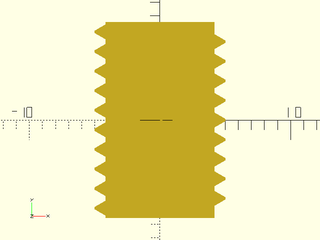
include <BOSL2/std.scad>
include <BOSL2/threading.scad>
projection(cut=true)
threaded_rod(d=10, l=15, pitch=1.5, orient=BACK);
Example 2:
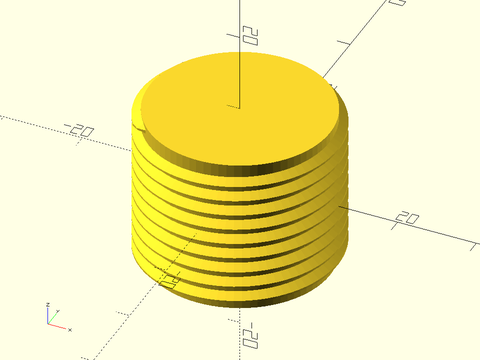
include <BOSL2/std.scad>
include <BOSL2/threading.scad>
threaded_rod(d=25, height=20, pitch=2, $fa=1, $fs=1);
Example 3:

include <BOSL2/std.scad>
include <BOSL2/threading.scad>
threaded_rod(d=10, l=20, pitch=1.25, left_handed=true, $fa=1, $fs=1);
Example 4:
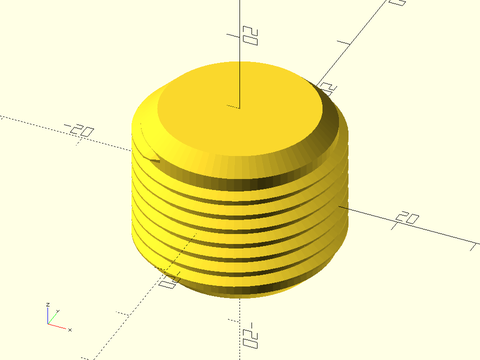
include <BOSL2/std.scad>
include <BOSL2/threading.scad>
threaded_rod(d=25, l=20, pitch=2, $fa=1, $fs=1, end_len=1.5, bevel=true);
Example 5:
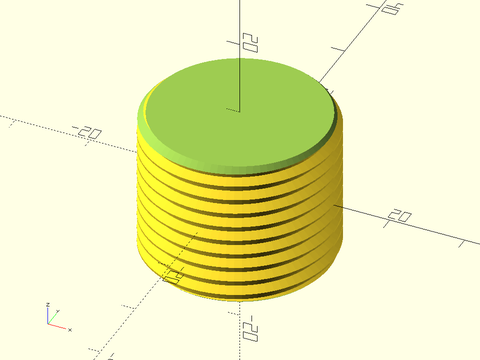
include <BOSL2/std.scad>
include <BOSL2/threading.scad>
threaded_rod(d=25, l=20, pitch=2, $fa=1, $fs=1, blunt_start=false);
Example 6: Masking a Horizontal Threaded Hole
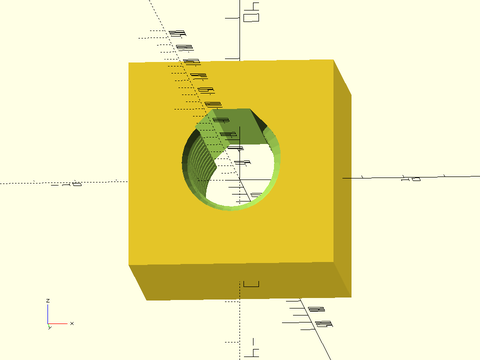
include <BOSL2/std.scad>
include <BOSL2/threading.scad>
difference() {
cuboid(50);
threaded_rod(
d=25, l=51, pitch=4, $fn=36,
internal=true, bevel=true,
blunt_start=false,
teardrop=true, orient=FWD
);
}
Example 7: Diamond threading where both left-handed and right-handed nuts travel (in the same direction) on the threaded rod:
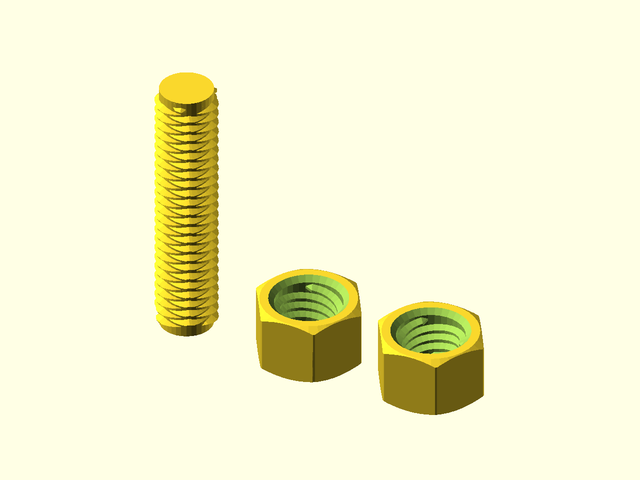
include <BOSL2/std.scad>
include <BOSL2/threading.scad>
$fn=32;
$slop = 0.075;
d = 3/8*INCH;
pitch = 1/16*INCH;
starts=3;
xdistribute(19){
intersection(){
threaded_rod(l=40, pitch=pitch, d=d,starts=starts,anchor=BOTTOM,end_len=.44);
threaded_rod(l=40, pitch=pitch, d=d, left_handed=true,starts=starts,anchor=BOTTOM);
}
threaded_nut(nutwidth=4.5/8*INCH,id=d,h=3/8*INCH,pitch=pitch,starts=starts,anchor=BOTTOM);
threaded_nut(nutwidth=4.5/8*INCH,id=d,h=3/8*INCH,pitch=pitch,starts=starts,left_handed=true,anchor=BOTTOM);
}
Synopsis: Creates an UTS/ISO triangular threaded nut. [Geom]
See Also: threaded_rod()
Usage:
- threaded_nut(nutwidth, id, h|height|thickness, pitch,...) [ATTACHMENTS];
Description:
Constructs a hex nut or square nut for an ISO (metric) or UTS (English) threaded rod. The inner diameter is measured from the bottom of the threads.
Arguments:
| By Position | What it does |
|---|---|
nutwidth |
flat to flat width of nut |
id |
inner diameter of threaded hole, measured from bottom of threads |
h / height / l / length / thickness
|
height/thickness of nut. |
pitch |
Distance between threads, or zero for no threads. |
| By Name | What it does |
|---|---|
shape |
specifies shape of nut, either "hex" or "square". Default: "hex" |
left_handed |
if true, create left-handed threads. Default = false |
starts |
The number of lead starts. Default: 1 |
bevel |
if true, bevel the outside of the nut. Default: true for hex nuts, false for square nuts |
bevel1 |
if true, bevel the outside of the nut bottom. |
bevel2 |
if true, bevel the outside of the nut top. |
bevang |
set the angle for the outside nut bevel. Default: 30 |
ibevel |
if true, bevel the inside (the hole). Default: true |
ibevel1 |
if true bevel the inside, bottom end. |
ibevel2 |
if true bevel the inside, top end. |
blunt_start |
If true apply truncated blunt start threads at both ends. Default: true |
blunt_start1 |
If true apply truncated blunt start threads bottom end. |
blunt_start2 |
If true apply truncated blunt start threads top end. |
end_len |
Specify the unthreaded length at the end after blunt start threads. Default: 0 |
end_len1 |
Specify unthreaded length at the bottom |
end_len2 |
Specify unthreaded length at the top |
lead_in |
Specify linear length of the lead in section of the threading with blunt start threads |
lead_in1 |
Specify linear length of the lead in section of the threading at the bottom with blunt start threads |
lead_in2 |
Specify linear length of the lead in section of the threading at the top with blunt start threads |
lead_in_ang |
Specify angular length in degrees of the lead in section of the threading with blunt start threads |
lead_in_ang1 |
Specify angular length in degrees of the lead in section of the threading at the bottom with blunt start threads |
lead_in_ang2 |
Specify angular length in degrees of the lead in section of the threading at the top with blunt start threads |
lead_in_shape |
Specify the shape of the thread lead in by giving a text string or function. Default: "default" |
anchor |
Translate so anchor point is at origin (0,0,0). See anchor. Default: CENTER
|
spin |
Rotate this many degrees around the Z axis after anchor. See spin. Default: 0
|
orient |
Vector to rotate top towards, after spin. See orient. Default: UP
|
$slop |
The printer-specific slop value, which adds clearance (4*$slop) to internal threads. |
Example 1:
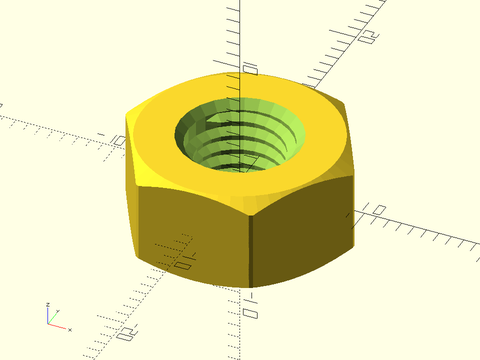
include <BOSL2/std.scad>
include <BOSL2/threading.scad>
threaded_nut(nutwidth=16, id=8, h=8, pitch=1.25, $slop=0.05, $fa=1, $fs=1);
Example 2:
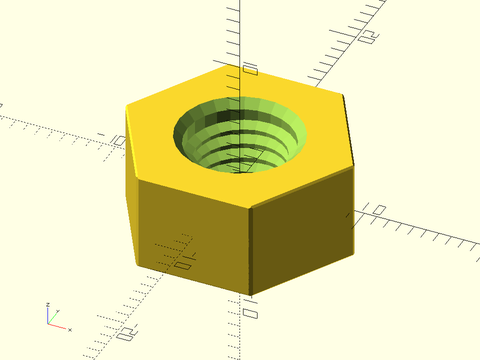
include <BOSL2/std.scad>
include <BOSL2/threading.scad>
threaded_nut(nutwidth=16, id=8, h=8, pitch=1.25, left_handed=true, bevel=false, $slop=0.1, $fa=1, $fs=1);
Example 3:
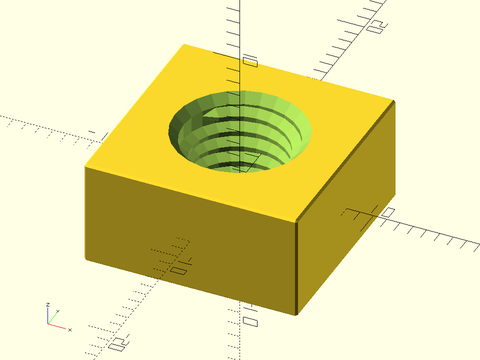
include <BOSL2/std.scad>
include <BOSL2/threading.scad>
threaded_nut(shape="square", nutwidth=16, id=8, h=8, pitch=1.25, $slop=0.1, $fa=1, $fs=1);
Example 4:
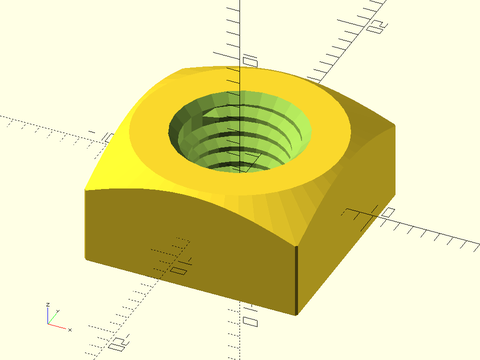
include <BOSL2/std.scad>
include <BOSL2/threading.scad>
threaded_nut(shape="square", nutwidth=16, id=8, h=8, pitch=1.25, bevel2=true, $slop=0.1, $fa=1, $fs=1);
Example 5:
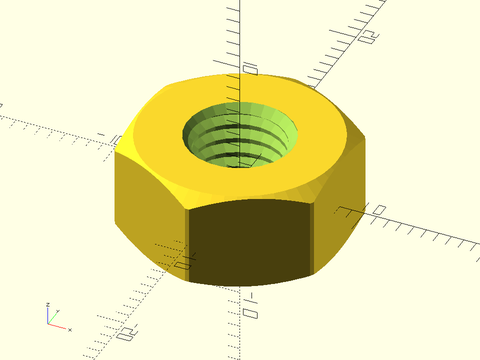
include <BOSL2/std.scad>
include <BOSL2/threading.scad>
rot(90)threaded_nut(nutwidth=16, id=8, h=8, pitch=1.25,blunt_start=false, $slop=0.1, $fa=1, $fs=1);
Synopsis: Creates a trapezoidal threaded rod. [Geom]
See Also: trapezoidal_threaded_nut()
Usage:
- trapezoidal_threaded_rod(d, l|length, pitch, [thread_angle=|flank_angle=], [thread_depth=], [internal=], ...) [ATTACHMENTS];
Description:
Constructs a threaded rod with a symmetric trapezoidal thread. Trapezoidal threads are used for lead screws because they are one of the strongest symmetric profiles. This tooth shape is stronger than a similarly sized square thread becuase of its wider base. However, it does place a radial load on the nut, unlike the square thread. For loads in only one direction the asymmetric buttress thread profile can bear greater loads.
By default produces the nominal dimensions for metric trapezoidal threads: a thread angle of 30 degrees and a depth set to half the pitch. You can also specify your own trapezoid parameters. For ACME threads see acme_threaded_rod().
Figure 3.1.1:
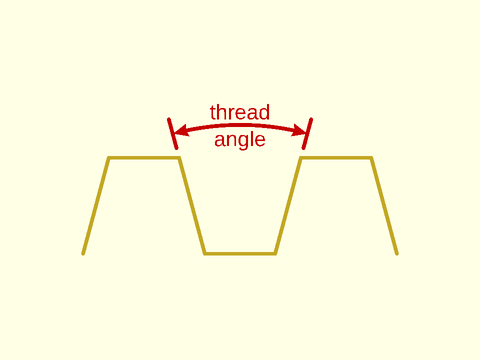
Figure 3.1.2:
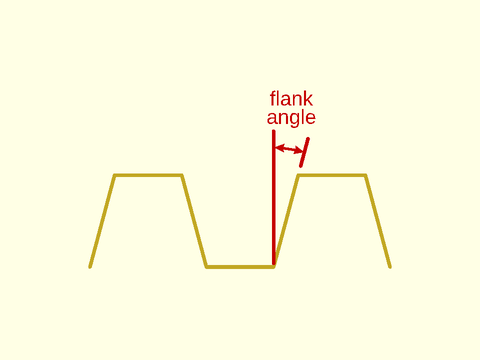
Arguments:
| By Position | What it does |
|---|---|
d |
Outer diameter of threaded rod. |
l / length / h / height
|
Length of threaded rod. |
pitch |
Thread spacing. |
| By Name | What it does |
|---|---|
thread_angle |
Angle between two thread faces. Default: 30 |
thread_depth |
Depth of threads. Default: pitch/2 |
flank_angle |
Angle of thread faces to plane perpendicular to screw. |
left_handed |
If true, create left-handed threads. Default: false |
starts |
The number of lead starts. Default: 1 |
bevel |
if true, bevel the thread ends. Default: false |
bevel1 |
if true bevel the bottom end. |
bevel2 |
if true bevel the top end. |
internal |
If true, make this a mask for making internal threads. Default: false |
d1 |
Bottom outside diameter of threads. |
d2 |
Top outside diameter of threads. |
blunt_start |
If true apply truncated blunt start threads at both ends. Default: true |
blunt_start1 |
If true apply truncated blunt start threads bottom end. |
blunt_start2 |
If true apply truncated blunt start threads top end. |
end_len |
Specify the unthreaded length at the end after blunt start threads. Default: 0 |
end_len1 |
Specify unthreaded length at the bottom |
end_len2 |
Specify unthreaded length at the top |
lead_in |
Specify linear length of the lead in section of the threading with blunt start threads |
lead_in1 |
Specify linear length of the lead in section of the threading at the bottom with blunt start threads |
lead_in2 |
Specify linear length of the lead in section of the threading at the top with blunt start threads |
lead_in_ang |
Specify angular length in degrees of the lead in section of the threading with blunt start threads |
lead_in_ang1 |
Specify angular length in degrees of the lead in section of the threading at the bottom with blunt start threads |
lead_in_ang2 |
Specify angular length in degrees of the lead in section of the threading at the top with blunt start threads |
lead_in_shape |
Specify the shape of the thread lead in by giving a text string or function. Default: "default" |
teardrop |
If true, adds a teardrop profile to the back (Y+) side of the threaded rod, for 3d printability of horizontal holes. If numeric, specifies the proportional extra distance of the teardrop flat top from the screw center, or set to "max" for a pointed teardrop. Default: false |
anchor |
Translate so anchor point is at origin (0,0,0). See anchor. Default: CENTER
|
spin |
Rotate this many degrees around the Z axis after anchor. See spin. Default: 0
|
orient |
Vector to rotate top towards, after spin. See orient. Default: UP
|
$slop |
The printer-specific slop value, which adds clearance (4*$slop) to internal threads. |
Example 1:
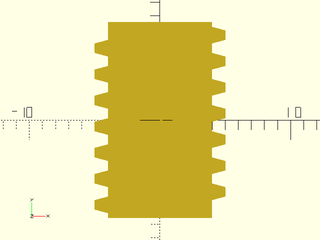
include <BOSL2/std.scad>
include <BOSL2/threading.scad>
projection(cut=true)
trapezoidal_threaded_rod(d=10, l=15, pitch=2, orient=BACK);
Example 2:

include <BOSL2/std.scad>
include <BOSL2/threading.scad>
trapezoidal_threaded_rod(d=10, l=40, pitch=2, $fn=32); // Standard metric threading
Example 3:
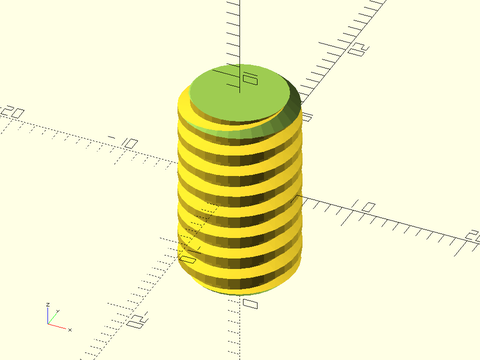
include <BOSL2/std.scad>
include <BOSL2/threading.scad>
rot(-65)trapezoidal_threaded_rod(d=10, l=17, pitch=2, blunt_start=false, $fn=32); // Standard metric threading
Example 4:
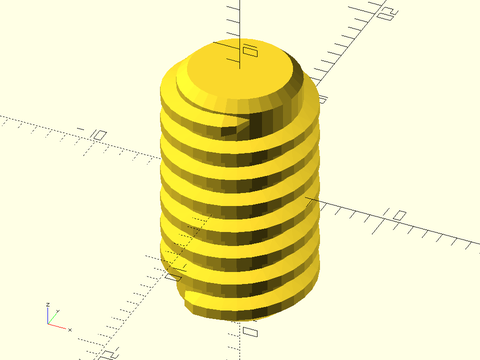
include <BOSL2/std.scad>
include <BOSL2/threading.scad>
trapezoidal_threaded_rod(d=10, l=17, pitch=2, bevel=true, $fn=32); // Standard metric threading
Example 5:
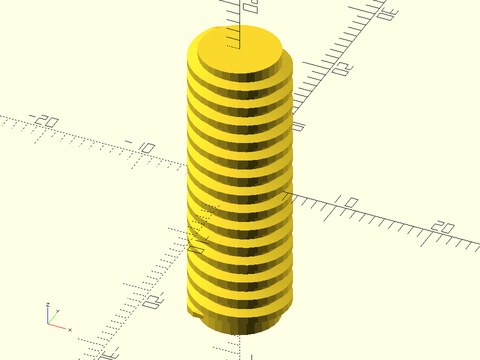
include <BOSL2/std.scad>
include <BOSL2/threading.scad>
trapezoidal_threaded_rod(d=10, h=30, pitch=2, left_handed=true, $fa=1, $fs=1); // Standard metric threading
Example 6:
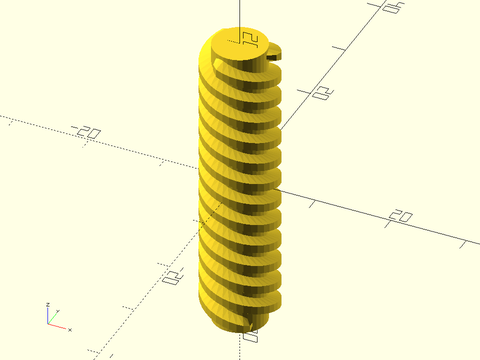
include <BOSL2/std.scad>
include <BOSL2/threading.scad>
trapezoidal_threaded_rod(d=10, l=40, pitch=3, left_handed=true, starts=3, $fn=36);
Example 7:
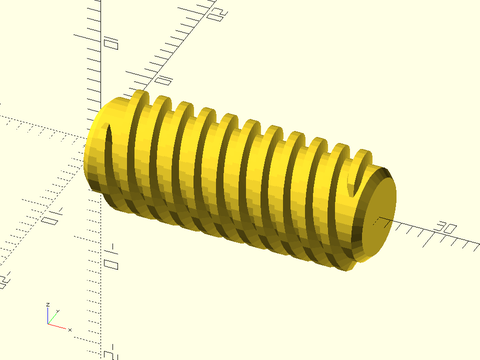
include <BOSL2/std.scad>
include <BOSL2/threading.scad>
trapezoidal_threaded_rod(l=25, d=10, pitch=2, starts=3, $fa=1, $fs=1, bevel=true, orient=RIGHT, anchor=BOTTOM);
Example 8:

include <BOSL2/std.scad>
include <BOSL2/threading.scad>
trapezoidal_threaded_rod(d=60, l=16, pitch=8, thread_depth=3, thread_angle=90, blunt_start=false, $fa=2, $fs=2);
Example 9:
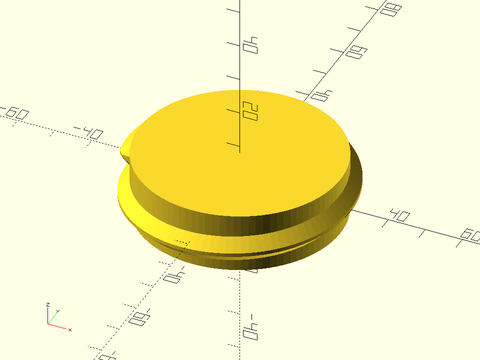
include <BOSL2/std.scad>
include <BOSL2/threading.scad>
trapezoidal_threaded_rod(d=60, l=16, pitch=8, thread_depth=3, thread_angle=90, end_len=0, $fa=2, $fs=2);
Example 10:
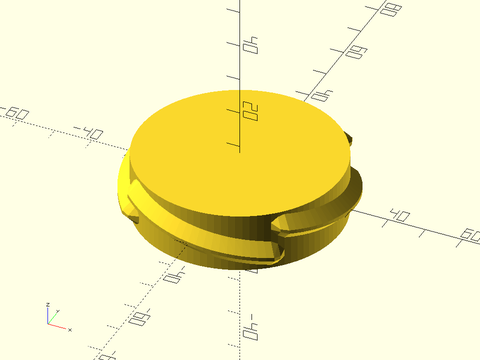
include <BOSL2/std.scad>
include <BOSL2/threading.scad>
trapezoidal_threaded_rod(d=60, l=16, pitch=8, thread_depth=3, thread_angle=90, left_handed=true, starts=4, $fa=2, $fs=2,end_len=0);
Example 11:
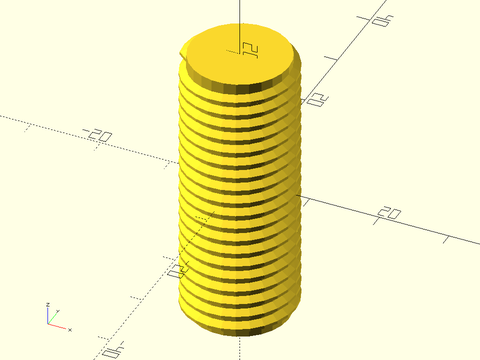
include <BOSL2/std.scad>
include <BOSL2/threading.scad>
trapezoidal_threaded_rod(d=16, l=40, pitch=2, thread_angle=60);
Example 12:
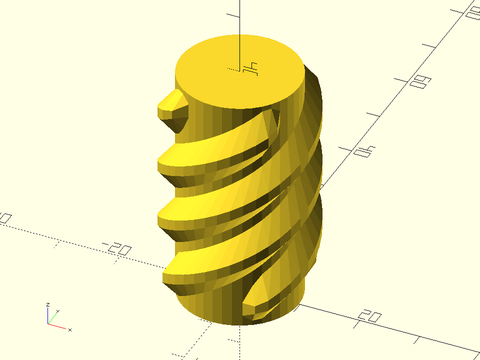
include <BOSL2/std.scad>
include <BOSL2/threading.scad>
trapezoidal_threaded_rod(d=25, l=40, pitch=10, thread_depth=8/3, thread_angle=100, starts=4, anchor=BOT, $fa=2, $fs=2,end_len=-2);
Example 13:
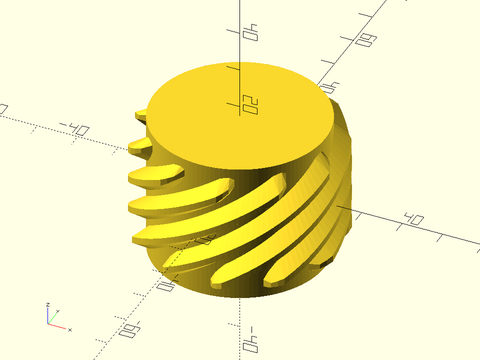
include <BOSL2/std.scad>
include <BOSL2/threading.scad>
trapezoidal_threaded_rod(d=50, l=35, pitch=8, thread_angle=60, starts=11, lead_in=3, $fn=120);
Example 14:
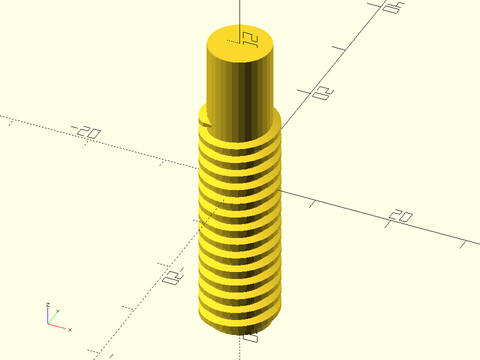
include <BOSL2/std.scad>
include <BOSL2/threading.scad>
trapezoidal_threaded_rod(d=10, l=40, end_len2=10, pitch=2, $fn=32); // Unthreaded top end section
Example 15: Using as a Mask to Make Internal Threads
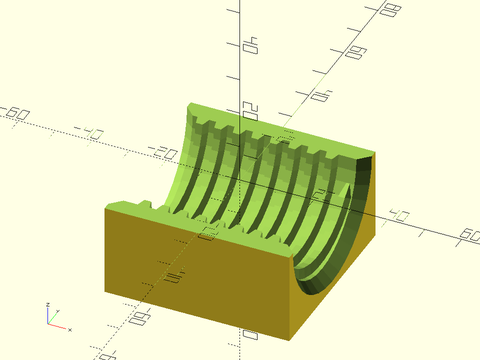
include <BOSL2/std.scad>
include <BOSL2/threading.scad>
bottom_half() difference() {
cube(50, center=true);
trapezoidal_threaded_rod(d=40, l=51, pitch=5, thread_angle=30, internal=true, bevel=true, orient=RIGHT, $fn=36);
}
Example 16: Masking a Horizontal Threaded Hole
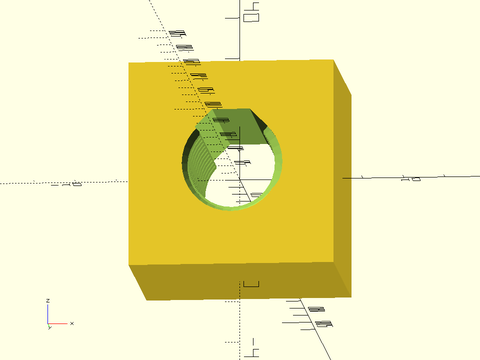
include <BOSL2/std.scad>
include <BOSL2/threading.scad>
difference() {
cuboid(50);
trapezoidal_threaded_rod(
d=25, l=51, pitch=4, $fn=36,
thread_angle=30,
internal=true, bevel=true,
blunt_start=false,
teardrop=true, orient=FWD
);
}
Synopsis: Creates a trapezoidal threaded nut. [Geom]
See Also: trapezoidal_threaded_rod()
Usage:
- trapezoidal_threaded_nut(nutwidth, id, h|height|thickness, pitch, [thread_angle=|flank_angle=], [thread_depth], ...) [ATTACHMENTS];
Description:
Constructs a hex nut or square nut for a symmetric trapzoidal threaded rod. By default produces the nominal dimensions for metric trapezoidal threads: a thread angle of 30 degrees and a depth set to half the pitch. You can also specify your own trapezoid parameters. For ACME threads see acme_threaded_nut().
Arguments:
| By Position | What it does |
|---|---|
nutwidth |
flat to flat width of nut |
id |
inner diameter of threaded hole, measured from bottom of threads |
h / height / l / length / thickness
|
height/thickness of nut. |
pitch |
Thread spacing. |
| By Name | What it does |
|---|---|
thread_angle |
Angle between two thread faces. Default: 30 |
thread_depth |
Depth of the threads. Default: pitch/2 |
flank_angle |
Angle of thread faces to plane perpendicular to screw. |
shape |
specifies shape of nut, either "hex" or "square". Default: "hex" |
left_handed |
if true, create left-handed threads. Default = false |
starts |
The number of lead starts. Default = 1 |
bevel |
if true, bevel the outside of the nut. Default: true for hex nuts, false for square nuts |
bevel1 |
if true, bevel the outside of the nut bottom. |
bevel2 |
if true, bevel the outside of the nut top. |
bevang |
set the angle for the outside nut bevel. Default: 30 |
ibevel |
if true, bevel the inside (the hole). Default: true |
ibevel1 |
if true bevel the inside, bottom end. |
ibevel2 |
if true bevel the inside, top end. |
blunt_start |
If true apply truncated blunt start threads at both ends. Default: true |
blunt_start1 |
If true apply truncated blunt start threads bottom end. |
blunt_start2 |
If true apply truncated blunt start threads top end. |
end_len |
Specify the unthreaded length at the end after blunt start threads. Default: 0 |
end_len1 |
Specify unthreaded length at the bottom |
end_len2 |
Specify unthreaded length at the top |
lead_in |
Specify linear length of the lead in section of the threading with blunt start threads |
lead_in1 |
Specify linear length of the lead in section of the threading at the bottom with blunt start threads |
lead_in2 |
Specify linear length of the lead in section of the threading at the top with blunt start threads |
lead_in_ang |
Specify angular length in degrees of the lead in section of the threading with blunt start threads |
lead_in_ang1 |
Specify angular length in degrees of the lead in section of the threading at the bottom with blunt start threads |
lead_in_ang2 |
Specify angular length in degrees of the lead in section of the threading at the top with blunt start threads |
lead_in_shape |
Specify the shape of the thread lead in by giving a text string or function. Default: "default" |
anchor |
Translate so anchor point is at origin (0,0,0). See anchor. Default: CENTER
|
spin |
Rotate this many degrees around the Z axis after anchor. See spin. Default: 0
|
orient |
Vector to rotate top towards, after spin. See orient. Default: UP
|
$slop |
The printer-specific slop value, which adds clearance (4*$slop) to internal threads. |
Example 1:
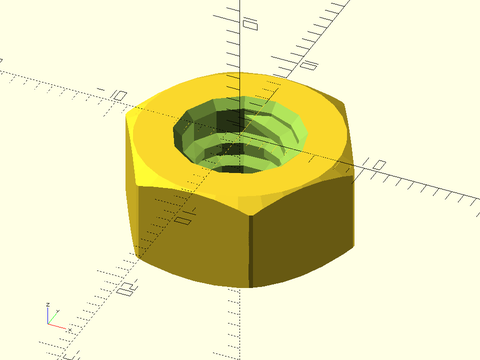
include <BOSL2/std.scad>
include <BOSL2/threading.scad>
trapezoidal_threaded_nut(nutwidth=16, id=8, h=8, pitch=2, $slop=0.1, anchor=UP);
Example 2:
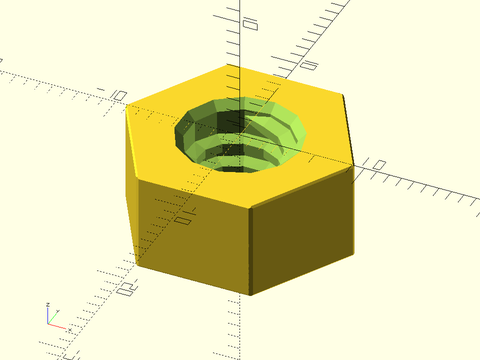
include <BOSL2/std.scad>
include <BOSL2/threading.scad>
trapezoidal_threaded_nut(nutwidth=16, id=8, h=8, pitch=2, bevel=false, $slop=0.05, anchor=UP);
Example 3:
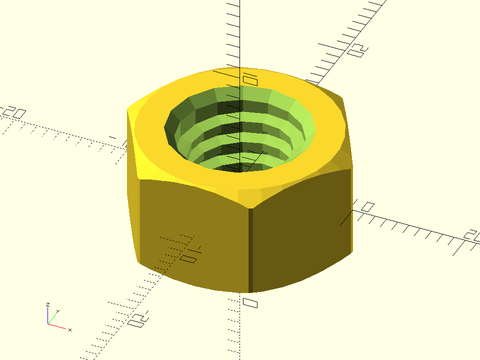
include <BOSL2/std.scad>
include <BOSL2/threading.scad>
trapezoidal_threaded_nut(nutwidth=17.4, id=10, h=10, pitch=2, $slop=0.1, left_handed=true);
Example 4:
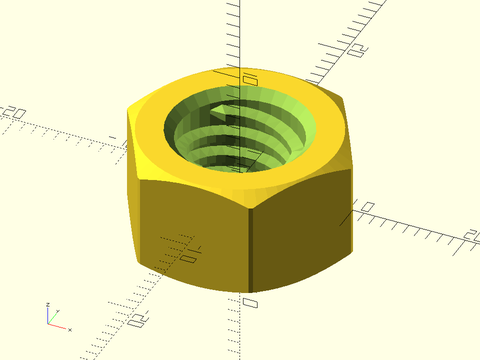
include <BOSL2/std.scad>
include <BOSL2/threading.scad>
trapezoidal_threaded_nut(nutwidth=17.4, id=10, h=10, pitch=2, starts=3, $fa=1, $fs=1, $slop=0.15);
Example 5:

include <BOSL2/std.scad>
include <BOSL2/threading.scad>
trapezoidal_threaded_nut(nutwidth=17.4, id=10, h=10, pitch=2, starts=3, $fa=1, $fs=1, $slop=0.15, blunt_start=false);
Example 6:
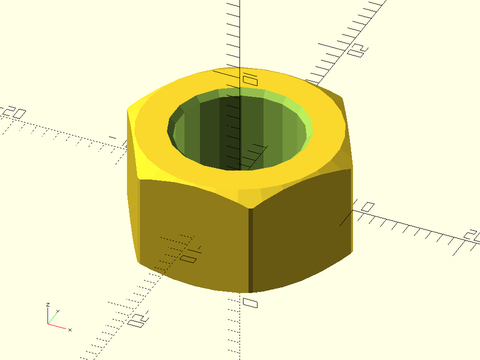
include <BOSL2/std.scad>
include <BOSL2/threading.scad>
trapezoidal_threaded_nut(nutwidth=17.4, id=10, h=10, pitch=0, $slop=0.2); // No threads
Synopsis: Creates an ACME threaded rod. [Geom]
See Also: acme_threaded_nut()
Usage:
- acme_threaded_rod(d, l|length, tpi|pitch=, [internal=], ...) [ATTACHMENTS];
Description:
Constructs an ACME trapezoidal threaded screw rod. This form has a 29 degree thread angle with a symmetric trapezoidal thread.
Arguments:
| By Position | What it does |
|---|---|
d |
Outer diameter of threaded rod. |
l / length / h / height
|
Length of threaded rod. |
tpi |
threads per inch. |
| By Name | What it does |
|---|---|
pitch |
thread spacing (alternative to tpi) |
starts |
The number of lead starts. Default = 1 |
left_handed |
if true, create left-handed threads. Default = false |
bevel |
if true, bevel the thread ends. Default: false |
bevel1 |
if true bevel the bottom end. |
bevel2 |
if true bevel the top end. |
internal |
If true, this is a mask for making internal threads. |
blunt_start |
If true apply truncated blunt start threads at both ends. Default: true |
blunt_start1 |
If true apply truncated blunt start threads bottom end. |
blunt_start2 |
If true apply truncated blunt start threads top end. |
end_len |
Specify the unthreaded length at the end after blunt start threads. Default: 0 |
end_len1 |
Specify unthreaded length at the bottom |
end_len2 |
Specify unthreaded length at the top |
lead_in |
Specify linear length of the lead in section of the threading with blunt start threads |
lead_in1 |
Specify linear length of the lead in section of the threading at the bottom with blunt start threads |
lead_in2 |
Specify linear length of the lead in section of the threading at the top with blunt start threads |
lead_in_ang |
Specify angular length in degrees of the lead in section of the threading with blunt start threads |
lead_in_ang1 |
Specify angular length in degrees of the lead in section of the threading at the bottom with blunt start threads |
lead_in_ang2 |
Specify angular length in degrees of the lead in section of the threading at the top with blunt start threads |
lead_in_shape |
Specify the shape of the thread lead in by giving a text string or function. Default: "default" |
teardrop |
If true, adds a teardrop profile to the back (Y+) side of the threaded rod, for 3d printability of horizontal holes. If numeric, specifies the proportional extra distance of the teardrop flat top from the screw center, or set to "max" for a pointed teardrop. Default: false |
anchor |
Translate so anchor point is at origin (0,0,0). See anchor. Default: CENTER
|
spin |
Rotate this many degrees around the Z axis after anchor. See spin. Default: 0
|
orient |
Vector to rotate top towards, after spin. See orient. Default: UP
|
$slop |
The printer-specific slop value, which adds clearance (4*$slop) to internal threads. |
Example 1:
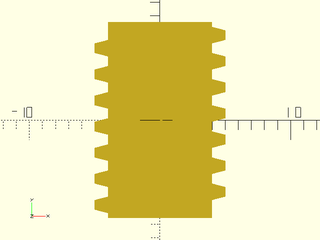
include <BOSL2/std.scad>
include <BOSL2/threading.scad>
projection(cut=true)
acme_threaded_rod(d=10, l=15, pitch=2, orient=BACK);
Example 2:
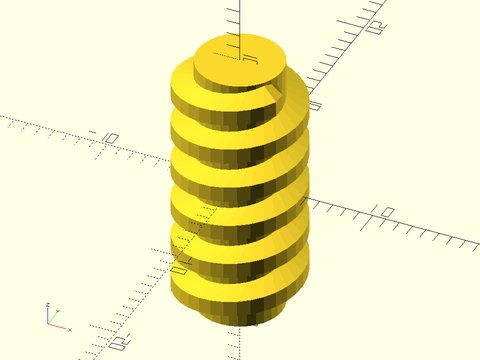
include <BOSL2/std.scad>
include <BOSL2/threading.scad>
acme_threaded_rod(d=3/8*INCH, l=20, pitch=1/8*INCH, $fn=32);
Example 3:
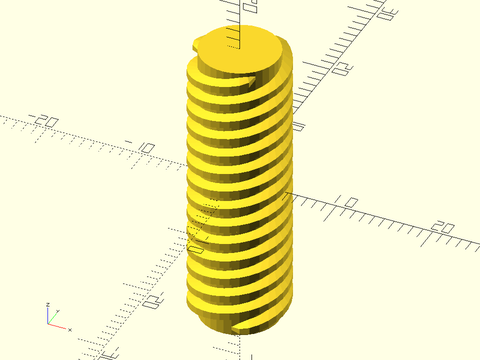
include <BOSL2/std.scad>
include <BOSL2/threading.scad>
acme_threaded_rod(d=10, l=30, pitch=2, starts=3, $fa=1, $fs=1);
Example 4: Masking a Horizontal Threaded Hole
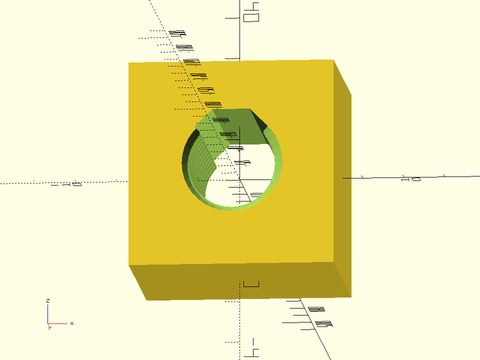
include <BOSL2/std.scad>
include <BOSL2/threading.scad>
difference() {
cuboid(50);
acme_threaded_rod(
d=25, l=51, pitch=4, $fn=36,
internal=true, bevel=true,
blunt_start=false,
teardrop=true, orient=FWD
);
}
Synopsis: Creates an ACME threaded nut. [Geom]
See Also: acme_threaded_rod()
Usage:
- acme_threaded_nut(nutwidth, id, h|height|thickness, tpi|pitch=, [shape=], ...) [ATTACHMENTS];
Description:
Constructs a hexagonal or square nut for an ACME threaded screw rod.
Arguments:
| By Position | What it does |
|---|---|
nutwidth |
flat to flat width of nut. |
id |
inner diameter of threaded hole, measured from bottom of threads |
h / height / l / length / thickness
|
height/thickness of nut. |
tpi |
threads per inch |
| By Name | What it does |
|---|---|
pitch |
Thread spacing (alternative to tpi) |
shape |
specifies shape of nut, either "hex" or "square". Default: "hex" |
left_handed |
if true, create left-handed threads. Default = false |
starts |
Number of lead starts. Default: 1 |
bevel |
if true, bevel the outside of the nut. Default: true for hex nuts, false for square nuts |
bevel1 |
if true, bevel the outside of the nut bottom. |
bevel2 |
if true, bevel the outside of the nut top. |
bevang |
set the angle for the outside nut bevel. Default: 30 |
ibevel |
if true, bevel the inside (the hole). Default: true |
ibevel1 |
if true bevel the inside, bottom end. |
ibevel2 |
if true bevel the inside, top end. |
blunt_start |
If true apply truncated blunt start threads at both ends. Default: true |
blunt_start1 |
If true apply truncated blunt start threads bottom end. |
blunt_start2 |
If true apply truncated blunt start threads top end. |
end_len |
Specify the unthreaded length at the end after blunt start threads. Default: 0 |
end_len1 |
Specify unthreaded length at the bottom |
end_len2 |
Specify unthreaded length at the top |
lead_in |
Specify linear length of the lead in section of the threading with blunt start threads |
lead_in1 |
Specify linear length of the lead in section of the threading at the bottom with blunt start threads |
lead_in2 |
Specify linear length of the lead in section of the threading at the top with blunt start threads |
lead_in_ang |
Specify angular length in degrees of the lead in section of the threading with blunt start threads |
lead_in_ang1 |
Specify angular length in degrees of the lead in section of the threading at the bottom with blunt start threads |
lead_in_ang2 |
Specify angular length in degrees of the lead in section of the threading at the top with blunt start threads |
lead_in_shape |
Specify the shape of the thread lead in by giving a text string or function. Default: "default" |
anchor |
Translate so anchor point is at origin (0,0,0). See anchor. Default: CENTER
|
spin |
Rotate this many degrees around the Z axis after anchor. See spin. Default: 0
|
orient |
Vector to rotate top towards, after spin. See orient. Default: UP
|
$slop |
The printer-specific slop value, which adds clearance (4*$slop) to internal threads. |
Example 1:
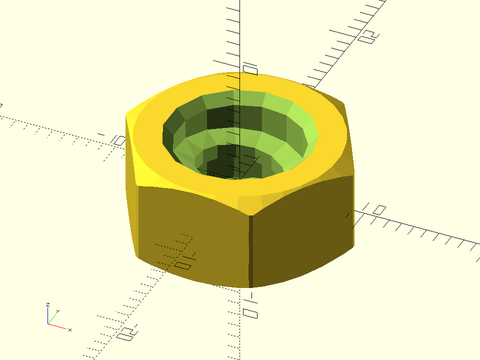
include <BOSL2/std.scad>
include <BOSL2/threading.scad>
acme_threaded_nut(nutwidth=16, id=3/8*INCH, h=8, tpi=8, $slop=0.05);
Example 2:
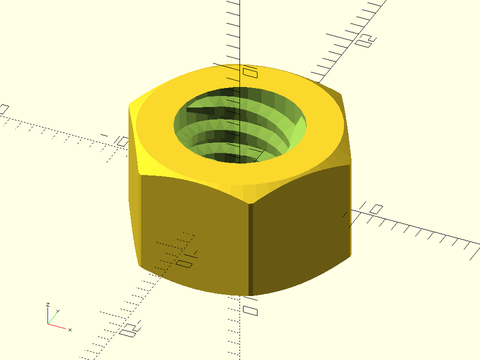
include <BOSL2/std.scad>
include <BOSL2/threading.scad>
acme_threaded_nut(nutwidth=16, id=3/8*INCH, h=10, tpi=12, starts=3, $slop=0.1, $fa=1, $fs=1, ibevel=false);
Example 3:
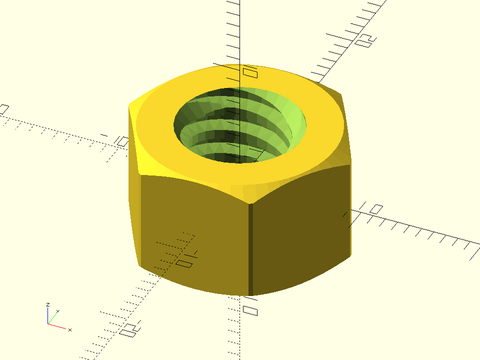
include <BOSL2/std.scad>
include <BOSL2/threading.scad>
acme_threaded_nut(nutwidth=16, id=3/8*INCH, h=10, tpi=12, starts=3, $slop=0.1, $fa=1, $fs=1, blunt_start=false);
Synopsis: Creates NPT pipe threading. [Geom]
See Also: acme_threaded_rod()
Usage:
- npt_threaded_rod(size, [internal=], ...) [ATTACHMENTS];
Description:
Constructs a standard NPT pipe end threading. If internal=true, creates a mask for making
internal pipe threads. Tapers smaller upwards if internal=false. Tapers smaller downwards
if internal=true. If hollow=true and internal=false, then the pipe threads will be
hollowed out into a pipe with the apropriate internal diameter.
Arguments:
| By Position | What it does |
|---|---|
size |
NPT standard pipe size in inches. 1/16", 1/8", 1/4", 3/8", 1/2", 3/4", 1", 1+1/4", 1+1/2", or 2". Default: 1/2" |
| By Name | What it does |
|---|---|
left_handed |
If true, create left-handed threads. Default = false |
bevel |
if true, bevel the thread ends. Default: false |
bevel1 |
if true bevel the bottom end. |
bevel2 |
if true bevel the top end. |
hollow |
If true, create a pipe with the correct internal diameter. |
internal |
If true, make this a mask for making internal threads. |
anchor |
Translate so anchor point is at origin (0,0,0). See anchor. Default: CENTER
|
spin |
Rotate this many degrees around the Z axis after anchor. See spin. Default: 0
|
orient |
Vector to rotate top towards, after spin. See orient. Default: UP
|
$slop |
The printer-specific slop value, which adds clearance (4*$slop) to internal threads. |
Example 1: The straight gray rectangle reveals the tapered threads.
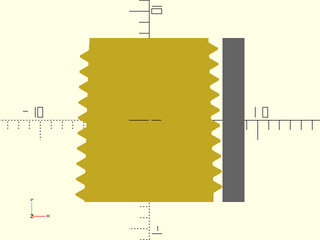
include <BOSL2/std.scad>
include <BOSL2/threading.scad>
projection(cut=true) npt_threaded_rod(size=1/4, orient=BACK);
right(.533*INCH/2) color("gray") rect([2,0.5946*INCH],anchor=LEFT);
Example 2:
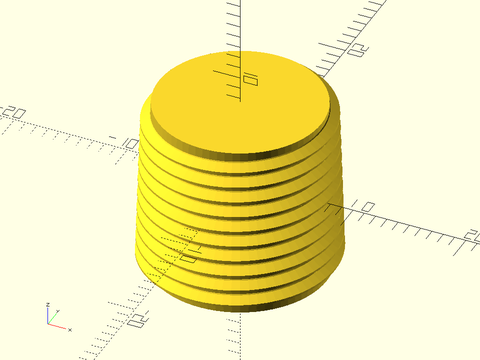
include <BOSL2/std.scad>
include <BOSL2/threading.scad>
npt_threaded_rod(size=3/8, $fn=72);
Example 3:
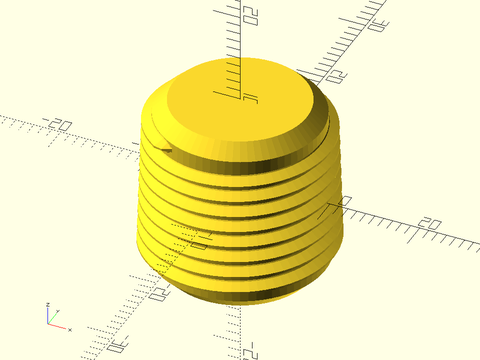
include <BOSL2/std.scad>
include <BOSL2/threading.scad>
npt_threaded_rod(size=1/2, $fn=72, bevel=true);
Example 4:
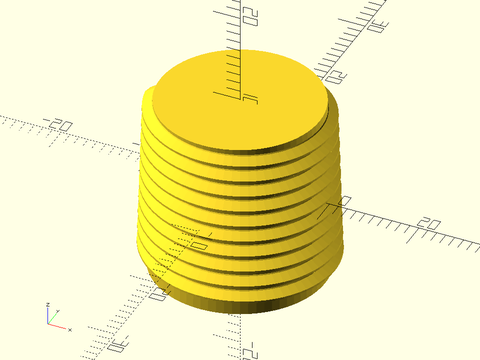
include <BOSL2/std.scad>
include <BOSL2/threading.scad>
npt_threaded_rod(size=1/2, left_handed=true, $fn=72);
Example 5:
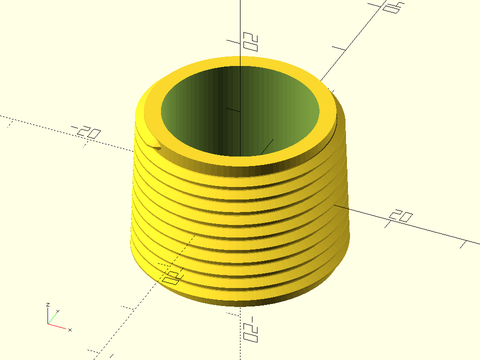
include <BOSL2/std.scad>
include <BOSL2/threading.scad>
npt_threaded_rod(size=3/4, hollow=true, $fn=96);
Example 6:
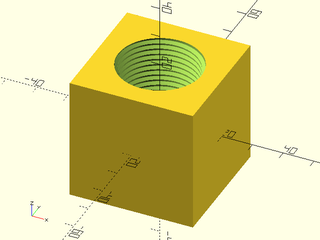
include <BOSL2/std.scad>
include <BOSL2/threading.scad>
diff("remove"){
cuboid([40,40,40])
tag("remove"){
up(.01)position(TOP)
npt_threaded_rod(size=3/4, $fn=96, internal=true, $slop=0.1, anchor=TOP);
cyl(d=3/4*INCH, l=42, $fn=32);
}
}
Synopsis: Creates a buttress-threaded rod. [Geom]
See Also: buttress_threaded_nut()
Usage:
- buttress_threaded_rod(d, l|length, pitch, [internal=], ...) [ATTACHMENTS];
Description:
Constructs a simple buttress threaded rod with a 45 degree angle. The buttress thread or sawtooth thread has low friction and high loading in one direction at the cost of higher friction and inferior loading in the other direction. Buttress threads are sometimes used on vises, which are loaded only in one direction.
Arguments:
| By Position | What it does |
|---|---|
d |
Outer diameter of threaded rod. |
l / length / h / height
|
Length of threaded rod. |
pitch |
Thread spacing. |
| By Name | What it does |
|---|---|
left_handed |
if true, create left-handed threads. Default = false |
starts |
Number of lead starts. Default: 1 |
bevel |
if true, bevel the thread ends. Default: false |
bevel1 |
if true bevel the bottom end. |
bevel2 |
if true bevel the top end. |
internal |
If true, this is a mask for making internal threads. |
blunt_start |
If true apply truncated blunt start threads at both ends. Default: true |
blunt_start1 |
If true apply truncated blunt start threads bottom end. |
blunt_start2 |
If true apply truncated blunt start threads top end. |
end_len |
Specify the unthreaded length at the end after blunt start threads. Default: 0 |
end_len1 |
Specify unthreaded length at the bottom |
end_len2 |
Specify unthreaded length at the top |
lead_in |
Specify linear length of the lead in section of the threading with blunt start threads |
lead_in1 |
Specify linear length of the lead in section of the threading at the bottom with blunt start threads |
lead_in2 |
Specify linear length of the lead in section of the threading at the top with blunt start threads |
lead_in_ang |
Specify angular length in degrees of the lead in section of the threading with blunt start threads |
lead_in_ang1 |
Specify angular length in degrees of the lead in section of the threading at the bottom with blunt start threads |
lead_in_ang2 |
Specify angular length in degrees of the lead in section of the threading at the top with blunt start threads |
lead_in_shape |
Specify the shape of the thread lead in by giving a text string or function. Default: "default" |
teardrop |
If true, adds a teardrop profile to the back (Y+) side of the threaded rod, for 3d printability of horizontal holes. If numeric, specifies the proportional extra distance of the teardrop flat top from the screw center, or set to "max" for a pointed teardrop. Default: false |
d1 |
Bottom outside diameter of threads. |
d2 |
Top outside diameter of threads. |
anchor |
Translate so anchor point is at origin (0,0,0). See anchor. Default: CENTER
|
spin |
Rotate this many degrees around the Z axis after anchor. See spin. Default: 0
|
orient |
Vector to rotate top towards, after spin. See orient. Default: UP
|
$slop |
The printer-specific slop value, which adds clearance (4*$slop) to internal threads. |
Example 1:
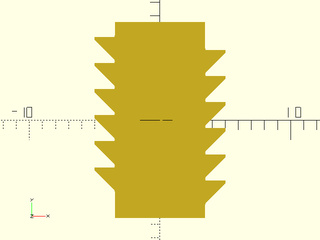
include <BOSL2/std.scad>
include <BOSL2/threading.scad>
projection(cut=true)
buttress_threaded_rod(d=10, l=15, pitch=2, orient=BACK);
Example 2:
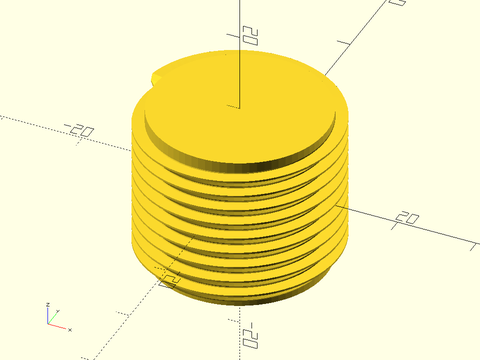
include <BOSL2/std.scad>
include <BOSL2/threading.scad>
buttress_threaded_rod(d=25, l=20, pitch=2, $fa=1, $fs=1,end_len=0);
Example 3:
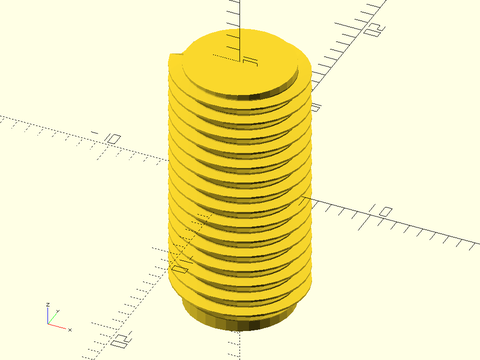
include <BOSL2/std.scad>
include <BOSL2/threading.scad>
buttress_threaded_rod(d=10, l=20, pitch=1.25, left_handed=true, $fa=1, $fs=1);
Example 4: Masking a Horizontal Threaded Hole
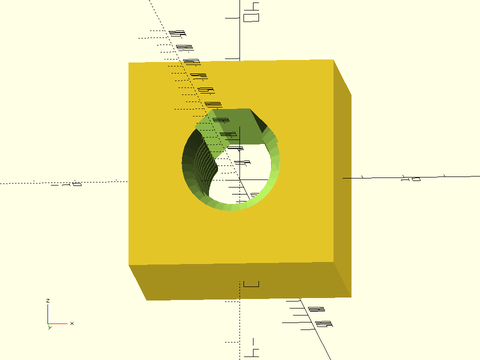
include <BOSL2/std.scad>
include <BOSL2/threading.scad>
difference() {
cuboid(50);
buttress_threaded_rod(
d=25, l=51, pitch=4, $fn=36,
internal=true, bevel=true,
blunt_start=false,
teardrop=true, orient=FWD
);
}
Synopsis: Creates a buttress-threaded nut. [Geom]
See Also: buttress_threaded_rod()
Usage:
- buttress_threaded_nut(nutwidth, id, h|height|thickness, pitch, ...) [ATTACHMENTS];
Description:
Constructs a hexagonal or square nut for a simple buttress threaded screw rod.
Arguments:
| By Position | What it does |
|---|---|
nutwidth |
diameter of the nut. |
id |
inner diameter of threaded hole, measured from bottom of threads |
h / height / l / length / thickness
|
height/thickness of nut. |
pitch |
Thread spacing. |
| By Name | What it does |
|---|---|
shape |
specifies shape of nut, either "hex" or "square". Default: "hex" |
left_handed |
if true, create left-handed threads. Default = false |
starts |
The number of lead starts. Default: 1 |
bevel |
if true, bevel the outside of the nut. Default: true for hex nuts, false for square nuts |
bevel1 |
if true, bevel the outside of the nut bottom. |
bevel2 |
if true, bevel the outside of the nut top. |
bevang |
set the angle for the outside nut bevel. Default: 30 |
ibevel |
if true, bevel the inside (the hole). Default: true |
ibevel1 |
if true bevel the inside, bottom end. |
ibevel2 |
if true bevel the inside, top end. |
blunt_start |
If true apply truncated blunt start threads at both ends. Default: true |
blunt_start1 |
If true apply truncated blunt start threads bottom end. |
blunt_start2 |
If true apply truncated blunt start threads top end. |
end_len |
Specify the unthreaded length at the end after blunt start threads. Default: 0 |
end_len1 |
Specify unthreaded length at the bottom |
end_len2 |
Specify unthreaded length at the top |
lead_in |
Specify linear length of the lead in section of the threading with blunt start threads |
lead_in1 |
Specify linear length of the lead in section of the threading at the bottom with blunt start threads |
lead_in2 |
Specify linear length of the lead in section of the threading at the top with blunt start threads |
lead_in_ang |
Specify angular length in degrees of the lead in section of the threading with blunt start threads |
lead_in_ang1 |
Specify angular length in degrees of the lead in section of the threading at the bottom with blunt start threads |
lead_in_ang2 |
Specify angular length in degrees of the lead in section of the threading at the top with blunt start threads |
lead_in_shape |
Specify the shape of the thread lead in by giving a text string or function. Default: "default" |
anchor |
Translate so anchor point is at origin (0,0,0). See anchor. Default: CENTER
|
spin |
Rotate this many degrees around the Z axis after anchor. See spin. Default: 0
|
orient |
Vector to rotate top towards, after spin. See orient. Default: UP
|
$slop |
The printer-specific slop value, which adds clearance (4*$slop) to internal threads. |
Example 1:
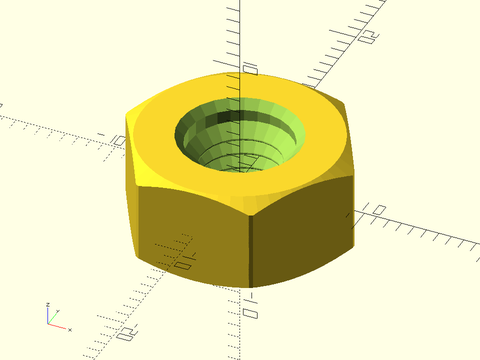
include <BOSL2/std.scad>
include <BOSL2/threading.scad>
buttress_threaded_nut(nutwidth=16, id=8, h=8, pitch=1.25, left_handed=true, $slop=0.05, $fa=1, $fs=1);
Synopsis: Creates a square-threaded rod. [Geom]
See Also: square_threaded_nut()
Usage:
- square_threaded_rod(d, l|length, pitch, [internal=], ...) [ATTACHMENTS];
Description:
Constructs a square profile threaded screw rod. The greatest advantage of square threads is that they have the least friction and a much higher intrinsic efficiency than trapezoidal threads. They produce no radial load on the nut. However, square threads cannot carry as much load as trapezoidal threads.
Arguments:
| By Position | What it does |
|---|---|
d |
Outer diameter of threaded rod. |
l / length / h / height
|
Length of threaded rod. |
pitch |
Thread spacing. |
| By Name | What it does |
|---|---|
left_handed |
if true, create left-handed threads. Default = false |
starts |
The number of lead starts. Default = 1 |
bevel |
if true, bevel the thread ends. Default: false |
bevel1 |
if true bevel the bottom end. |
bevel2 |
if true bevel the top end. |
internal |
If true, this is a mask for making internal threads. |
blunt_start |
If true apply truncated blunt start threads at both ends. Default: true |
blunt_start1 |
If true apply truncated blunt start threads bottom end. |
blunt_start2 |
If true apply truncated blunt start threads top end. |
end_len |
Specify the unthreaded length at the end after blunt start threads. Default: 0 |
end_len1 |
Specify unthreaded length at the bottom |
end_len2 |
Specify unthreaded length at the top |
lead_in |
Specify linear length of the lead in section of the threading with blunt start threads |
lead_in1 |
Specify linear length of the lead in section of the threading at the bottom with blunt start threads |
lead_in2 |
Specify linear length of the lead in section of the threading at the top with blunt start threads |
lead_in_ang |
Specify angular length in degrees of the lead in section of the threading with blunt start threads |
lead_in_ang1 |
Specify angular length in degrees of the lead in section of the threading at the bottom with blunt start threads |
lead_in_ang2 |
Specify angular length in degrees of the lead in section of the threading at the top with blunt start threads |
lead_in_shape |
Specify the shape of the thread lead in by giving a text string or function. Default: "default" |
teardrop |
If true, adds a teardrop profile to the back (Y+) side of the threaded rod, for 3d printability of horizontal holes. If numeric, specifies the proportional extra distance of the teardrop flat top from the screw center, or set to "max" for a pointed teardrop. Default: false |
d1 |
Bottom outside diameter of threads. |
d2 |
Top outside diameter of threads. |
anchor |
Translate so anchor point is at origin (0,0,0). See anchor. Default: CENTER
|
spin |
Rotate this many degrees around the Z axis after anchor. See spin. Default: 0
|
orient |
Vector to rotate top towards, after spin. See orient. Default: UP
|
$slop |
The printer-specific slop value, which adds clearance (4*$slop) to internal threads. |
Example 1:
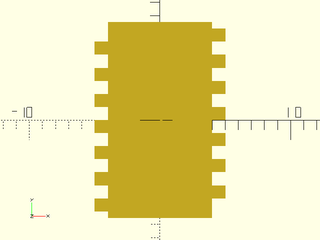
include <BOSL2/std.scad>
include <BOSL2/threading.scad>
projection(cut=true)
square_threaded_rod(d=10, l=15, pitch=2, orient=BACK);
Example 2:
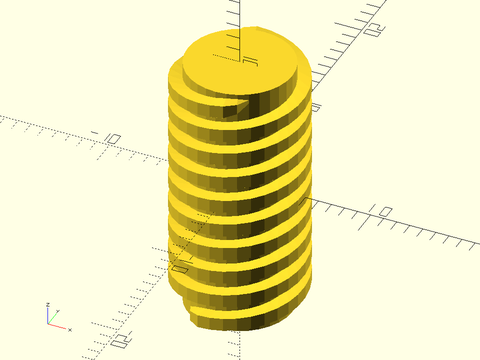
include <BOSL2/std.scad>
include <BOSL2/threading.scad>
square_threaded_rod(d=10, l=20, pitch=2, starts=2, $fn=32);
Example 3: Masking a Horizontal Threaded Hole
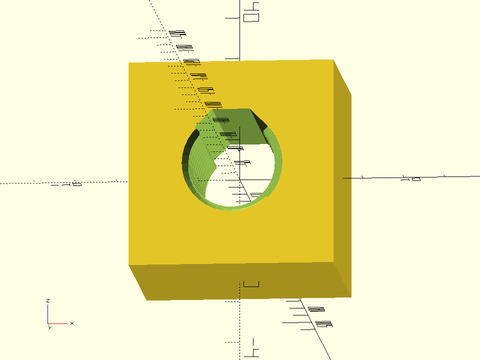
include <BOSL2/std.scad>
include <BOSL2/threading.scad>
difference() {
cuboid(50);
square_threaded_rod(
d=25, l=51, pitch=4, $fn=36,
internal=true, bevel=true,
blunt_start=false,
teardrop=true, orient=FWD
);
}
Synopsis: Creates a square-threaded nut. [Geom]
See Also: square_threaded_rod()
Usage:
- square_threaded_nut(nutwidth, id, h|height|thickness, pitch, ...) [ATTACHMENTS];
Description:
Constructs a hexagonal or square nut for a square profile threaded screw rod.
Arguments:
| By Position | What it does |
|---|---|
nutwidth |
diameter of the nut. |
id |
inner diameter of threaded hole, measured from bottom of threads |
h / height / l / length / thickness
|
height/thickness of nut. |
pitch |
Length between threads. |
| By Name | What it does |
|---|---|
shape |
specifies shape of nut, either "hex" or "square". Default: "hex" |
left_handed |
if true, create left-handed threads. Default = false |
starts |
The number of lead starts. Default = 1 |
bevel |
if true, bevel the outside of the nut. Default: true for hex nuts, false for square nuts |
bevel1 |
if true, bevel the outside of the nut bottom. |
bevel2 |
if true, bevel the outside of the nut top. |
bevang |
set the angle for the outside nut bevel. Default: 30 |
ibevel |
if true, bevel the inside (the hole). Default: true |
ibevel1 |
if true bevel the inside, bottom end. |
ibevel2 |
if true bevel the inside, top end. |
blunt_start |
If true apply truncated blunt start threads at both ends. Default: true |
blunt_start1 |
If true apply truncated blunt start threads bottom end. |
blunt_start2 |
If true apply truncated blunt start threads top end. |
end_len |
Specify the unthreaded length at the end after blunt start threads. Default: 0 |
end_len1 |
Specify unthreaded length at the bottom |
end_len2 |
Specify unthreaded length at the top |
lead_in |
Specify linear length of the lead in section of the threading with blunt start threads |
lead_in1 |
Specify linear length of the lead in section of the threading at the bottom with blunt start threads |
lead_in2 |
Specify linear length of the lead in section of the threading at the top with blunt start threads |
lead_in_ang |
Specify angular length in degrees of the lead in section of the threading with blunt start threads |
lead_in_ang1 |
Specify angular length in degrees of the lead in section of the threading at the bottom with blunt start threads |
lead_in_ang2 |
Specify angular length in degrees of the lead in section of the threading at the top with blunt start threads |
lead_in_shape |
Specify the shape of the thread lead in by giving a text string or function. Default: "default" |
anchor |
Translate so anchor point is at origin (0,0,0). See anchor. Default: CENTER
|
spin |
Rotate this many degrees around the Z axis after anchor. See spin. Default: 0
|
orient |
Vector to rotate top towards, after spin. See orient. Default: UP
|
$slop |
The printer-specific slop value, which adds clearance (4*$slop) to internal threads. |
Example 1:
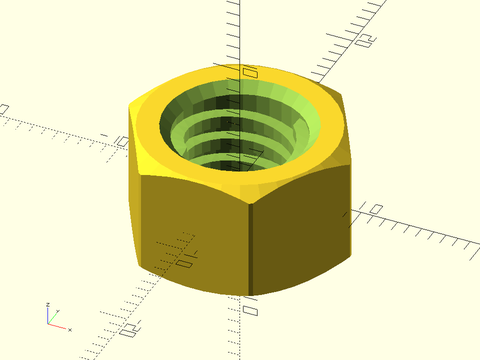
include <BOSL2/std.scad>
include <BOSL2/threading.scad>
square_threaded_nut(nutwidth=16, id=10, h=10, pitch=2, starts=2, $slop=0.1, $fn=32);
Synopsis: Creates a ball screw rod. [Geom]
Usage:
- ball_screw_rod(d, l|length, pitch, [ball_diam], [ball_arc], [internal=], ...) [ATTACHMENTS];
Description:
Constructs a ball screw rod. This type of rod is used with ball bearings.
Arguments:
| By Position | What it does |
|---|---|
d |
Outer diameter of threaded rod. |
l / length / h / height
|
Length of threaded rod. |
pitch |
Thread spacing. Also, the diameter of the ball bearings used. |
ball_diam |
The diameter of the ball bearings to use with this ball screw. |
ball_arc |
The arc portion that should touch the ball bearings. Default: 120 degrees. |
| By Name | What it does |
|---|---|
left_handed |
if true, create left-handed threads. Default = false |
starts |
The number of lead starts. Default = 1 |
bevel |
if true, bevel the thread ends. Default: false |
bevel1 |
if true bevel the bottom end. |
bevel2 |
if true bevel the top end. |
internal |
If true, make this a mask for making internal threads. |
blunt_start |
If true apply truncated blunt start threads at both ends. Default: true |
blunt_start1 |
If true apply truncated blunt start threads bottom end. |
blunt_start2 |
If true apply truncated blunt start threads top end. |
end_len |
Specify the unthreaded length at the end after blunt start threads. Default: 0 |
end_len1 |
Specify unthreaded length at the bottom |
end_len2 |
Specify unthreaded length at the top |
lead_in |
Specify linear length of the lead in section of the threading with blunt start threads |
lead_in1 |
Specify linear length of the lead in section of the threading at the bottom with blunt start threads |
lead_in2 |
Specify linear length of the lead in section of the threading at the top with blunt start threads |
lead_in_ang |
Specify angular length in degrees of the lead in section of the threading with blunt start threads |
lead_in_ang1 |
Specify angular length in degrees of the lead in section of the threading at the bottom with blunt start threads |
lead_in_ang2 |
Specify angular length in degrees of the lead in section of the threading at the top with blunt start threads |
lead_in_shape |
Specify the shape of the thread lead in by giving a text string or function. Default: "default" |
anchor |
Translate so anchor point is at origin (0,0,0). See anchor. Default: CENTER
|
spin |
Rotate this many degrees around the Z axis after anchor. See spin. Default: 0
|
orient |
Vector to rotate top towards, after spin. See orient. Default: UP
|
$slop |
The printer-specific slop value, which adds clearance (4*$slop) to internal threads. |
Example 1: Thread Profile, ball_diam=4, ball_arc=100
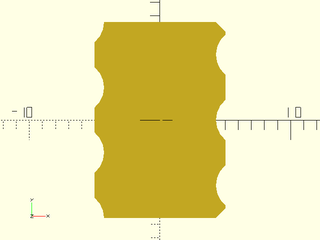
include <BOSL2/std.scad>
include <BOSL2/threading.scad>
projection(cut=true) ball_screw_rod(d=10, l=15, pitch=5, ball_diam=4, ball_arc=100, orient=BACK, $fn=24, blunt_start=false);
Example 2: Thread Profile, ball_diam=4, ball_arc=120
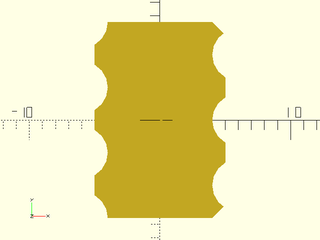
include <BOSL2/std.scad>
include <BOSL2/threading.scad>
projection(cut=true) ball_screw_rod(d=10, l=15, pitch=5, ball_diam=4, ball_arc=120, orient=BACK, $fn=24, blunt_start=false);
Example 3: Thread Profile, ball_diam=3, ball_arc=120
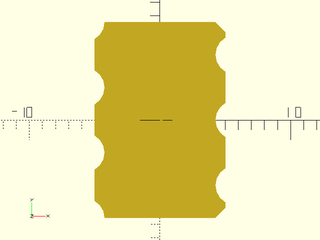
include <BOSL2/std.scad>
include <BOSL2/threading.scad>
projection(cut=true) ball_screw_rod(d=10, l=15, pitch=5, ball_diam=3, ball_arc=120, orient=BACK, $fn=24, blunt_start=false);
Example 4:
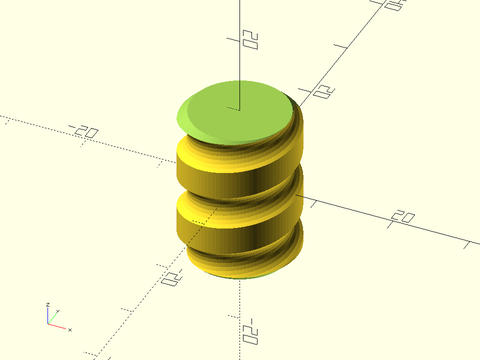
include <BOSL2/std.scad>
include <BOSL2/threading.scad>
ball_screw_rod(d=15, l=20, pitch=8, ball_diam=5, ball_arc=120, $fa=1, $fs=0.5, blunt_start=false);
Example 5:
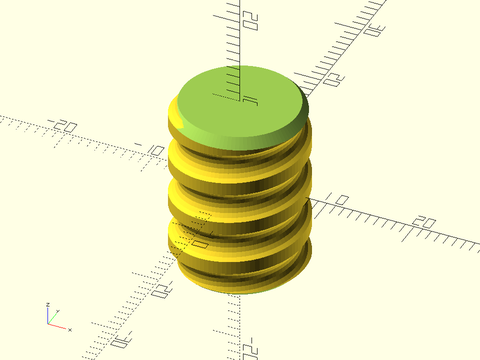
include <BOSL2/std.scad>
include <BOSL2/threading.scad>
ball_screw_rod(d=15, l=20, pitch=5, ball_diam=4, ball_arc=120, $fa=1, $fs=0.5, blunt_start=false);
Example 6:
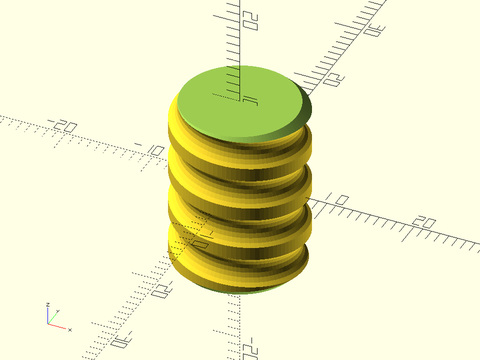
include <BOSL2/std.scad>
include <BOSL2/threading.scad>
ball_screw_rod(d=15, l=20, pitch=5, ball_diam=4, ball_arc=120, left_handed=true, $fa=1, $fs=0.5, blunt_start=false);
Synopsis: Creates a generic threaded rod. [Geom]
See Also: generic_threaded_nut()
Usage:
- generic_threaded_rod(d, l|length, pitch, profile, [internal=], ...) [ATTACHMENTS];
Description:
Constructs a generic threaded rod using an arbitrary thread profile that you supply. The rod can be tapered (e.g. for pipe threads). For specific thread types use other modules that supply the appropriate profile.
You give the profile as a 2D path that will be scaled by the pitch to produce the final thread shape. The profile
X values must be between -1/2 and 1/2. The Y=0 point will align with the specified rod diameter, so generally you
want a Y value of zero at the peak (which makes your specified diameter the outer diameter of the threads). The
value in the valleys of the thread should then be -depth/pitch due to the scaling by the thread pitch. The first
and last points should generally have the same Y value, but it is not necessary to give values at X=1/2 or X=-1/2
if unless the Y values differ from the interior points in the profile. Generally you should center the profile
horizontally in the interval [-1/2, 1/2].
If internal is true then produce a thread mask to difference from an object. When internal is true the rod
diameter is enlarged to correct for the polygonal nature of circles to ensure that the internal diameter is the
specified size. The diameter is also increased by 4 * $slop to create clearance for threading by allowing a 2 * $slop gap on each side. If bevel is set to true and internal is false then the ends of the rod will be beveled.
When bevel is true and internal is true the ends of the rod will be filled in so that the rod mask will create a
bevel when subtracted from an object. The bevel is at 45 deg and is the depth of the threads.
Blunt start threading, which is the default, specifies that the thread ends abruptly at its full width instead of
running off the end of the shaft and leaving a sharp edged partial thread at the end of the screw. This makes
screws easier to start and prevents cross threading. Blunt start threads should always be superior, and they are
faster to model, but if you really need standard threads that run off the end you can set blunt_start=false.
The teardrop option cuts off the threads with a teardrop for 3d printability of horizontal holes. By default, if the screw outer radius is r then the flat top will be at distance 1.05r from the center, adding a 5% space. You can set teardrop to a numerical value to adjust that percentage, e.g. a value of 0.1 would give a 10% space. You can set teardrop to "max" to create a pointy-top teardrop with no flat section.
Arguments:
| By Position | What it does |
|---|---|
d |
Outer diameter of threaded rod. |
l / length / h / height
|
Length of threaded rod. |
pitch |
Thread spacing. |
profile |
A 2D path giving the shape of a thread |
| By Name | What it does |
|---|---|
left_handed |
If true, create left-handed threads. Default: false |
starts |
The number of lead starts. Default: 1 |
internal |
If true, make this a mask for making internal threads. Default: false |
d1 |
Bottom outside diameter of threads. |
d2 |
Top outside diameter of threads. |
bevel |
set to true to bevel both ends, a number to specify a bevel size, false for no bevel, and "reverse" for an inverted bevel |
bevel1 |
set bevel for bottom end. |
bevel2 |
set bevel for top end. |
blunt_start |
If true apply truncated blunt start threads at both ends. Default: true |
blunt_start1 |
If true apply truncated blunt start threads bottom end. |
blunt_start2 |
If true apply truncated blunt start threads top end. |
end_len |
Specify the unthreaded length at the end after blunt start threads. Default: 0 |
end_len1 |
Specify unthreaded length at the bottom |
end_len2 |
Specify unthreaded length at the top |
lead_in |
Specify linear length of the lead in section of the threading with blunt start threads |
lead_in1 |
Specify linear length of the lead in section of the threading at the bottom with blunt start threads |
lead_in2 |
Specify linear length of the lead in section of the threading at the top with blunt start threads |
lead_in_ang |
Specify angular length in degrees of the lead in section of the threading with blunt start threads |
lead_in_ang1 |
Specify angular length in degrees of the lead in section of the threading at the bottom with blunt start threads |
lead_in_ang2 |
Specify angular length in degrees of the lead in section of the threading at the top with blunt start threads |
lead_in_shape |
Specify the shape of the thread lead in by giving a text string or function. Default: "default" |
teardrop |
If true, adds a teardrop profile to the back (Y+) side of the threaded rod, for 3d printability of horizontal holes. If numeric, specifies the proportional extra distance of the teardrop flat top from the screw center, or set to "max" for a pointed teardrop (see above). Default: false |
anchor |
Translate so anchor point is at origin (0,0,0). See anchor. Default: CENTER
|
spin |
Rotate this many degrees around the Z axis after anchor. See spin. Default: 0
|
orient |
Vector to rotate top towards, after spin. See orient. Default: UP
|
$slop |
The printer-specific slop value, which adds clearance (4*$slop) to internal threads. |
Example 1: Example Tooth Profile
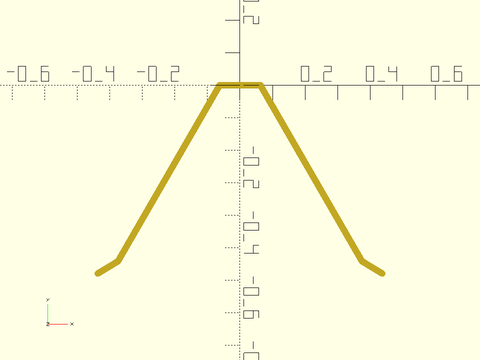
include <BOSL2/std.scad>
include <BOSL2/threading.scad>
pitch = 2;
depth = pitch * cos(30) * 5/8;
profile = [
[-7/16, -depth/pitch*1.07],
[-6/16, -depth/pitch],
[-1/16, 0],
[ 1/16, 0],
[ 6/16, -depth/pitch],
[ 7/16, -depth/pitch*1.07]
];
stroke(profile, width=0.02);
Example 2:
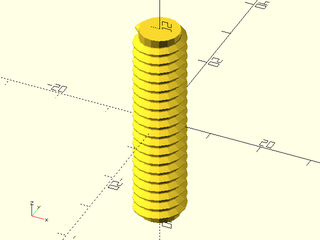
include <BOSL2/std.scad>
include <BOSL2/threading.scad>
pitch = 2;
depth = pitch * cos(30) * 5/8;
profile = [
[-7/16, -depth/pitch*1.07],
[-6/16, -depth/pitch],
[-1/16, 0],
[ 1/16, 0],
[ 6/16, -depth/pitch],
[ 7/16, -depth/pitch*1.07]
];
generic_threaded_rod(d=10, l=40, pitch=2, profile=profile);
Synopsis: Creates a generic threaded nut. [Geom]
See Also: generic_threaded_rod()
Usage:
- generic_threaded_nut(nutwidth, id, h|height|thickness, pitch, profile, [$slop], ...) [ATTACHMENTS];
Description:
Constructs a hexagonal or square nut for an generic threaded rod using a user-supplied thread profile.
See generic_threaded_rod() for details on the profile specification.
Arguments:
| By Position | What it does |
|---|---|
nutwidth |
outer dimension of nut from flat to flat. |
id |
inner diameter of threaded hole, measured from bottom of threads |
h / height / thickness
|
height/thickness of nut. |
pitch |
Thread spacing. |
profile |
Thread profile. |
| By Name | What it does |
|---|---|
shape |
specifies shape of nut, either "hex" or "square". Default: "hex" |
left_handed |
if true, create left-handed threads. Default = false |
starts |
The number of lead starts. Default = 1 |
id1 |
inner diameter at the bottom |
id2 |
inner diameter at the top |
bevel |
if true, bevel the outside of the nut. Default: true for hex nuts, false for square nuts |
bevel1 |
if true, bevel the outside of the nut bottom. |
bevel2 |
if true, bevel the outside of the nut top. |
bevang |
set the angle for the outside nut bevel. Default: 30 |
ibevel |
if true, bevel the inside (the hole). Default: true |
ibevel1 |
if true bevel the inside, bottom end. |
ibevel2 |
if true bevel the inside, top end. |
blunt_start |
If true apply truncated blunt start threads at both ends. Default: true |
blunt_start1 |
If true apply truncated blunt start threads bottom end. |
blunt_start2 |
If true apply truncated blunt start threads top end. |
end_len |
Specify the unthreaded length at the end after blunt start threads. Default: 0 |
end_len1 |
Specify unthreaded length at the bottom |
end_len2 |
Specify unthreaded length at the top |
lead_in |
Specify linear length of the lead in section of the threading with blunt start threads |
lead_in1 |
Specify linear length of the lead in section of the threading at the bottom with blunt start threads |
lead_in2 |
Specify linear length of the lead in section of the threading at the top with blunt start threads |
lead_in_ang |
Specify angular length in degrees of the lead in section of the threading with blunt start threads |
lead_in_ang1 |
Specify angular length in degrees of the lead in section of the threading at the bottom with blunt start threads |
lead_in_ang2 |
Specify angular length in degrees of the lead in section of the threading at the top with blunt start threads |
lead_in_shape |
Specify the shape of the thread lead in by giving a text string or function. Default: "default" |
anchor |
Translate so anchor point is at origin (0,0,0). See anchor. Default: CENTER
|
spin |
Rotate this many degrees around the Z axis after anchor. See spin. Default: 0
|
orient |
Vector to rotate top towards, after spin. See orient. Default: UP
|
$slop |
The printer-specific slop value, which adds clearance (4*$slop) to internal threads. |
Synopsis: Creates a thread helix to add to a cylinder. [Geom]
See Also: generic_threaded_rod()
Usage:
- thread_helix(d, pitch, turns=, [thread_depth=], [thread_angle=|flank_angle=], [profile=], [starts=], [internal=], ...) {ATTACHMENTS};
- thread_helix(d1=,d2=, pitch=, turns=, [thread_depth=], [thread_angle=|flank_angle=], [profile=], [starts=], [internal=], ...) {ATTACHMENTS};
Description:
Creates a right-handed helical thread with optional end tapering. Unlike
{{generic_threaded_rod()}, this module just generates the thread, and you specify the total
angle of threading that you want, which makes it easy to put complete threads onto a longer
shaft. It also optionally makes a finely divided taper at the thread ends. However, it takes
2-3 times as long to render compared to generic_threaded_rod(). This module was designed
to handle threads found in plastic and glass bottles.
You can specify a thread_depth and flank_angle, in which case you get a symmetric trapezoidal thread, whose inner diameter (the base of the threads for external threading) is d (so the total diameter will be d + thread_depth). This differs from the threaded_rod modules, where the specified diameter is the outer diameter. Alternatively you can give a profile, following the same rules as for general_threaded_rod. The Y=0 point will align with the specified diameter, and the profile should range in X from -1/2 to 1/2. You cannot specify both the profile and the thread_depth or flank_angle.
Unlike {{generic_threaded_rod()}, when internal=true this module generates the threads, not a thread mask. The profile needs to be inverted to produce the proper thread form. If you use the built-in trapezoidal thread you get the inverted thread, designed so that the inner diameter is d. If you supply a custom profile you must invert it yourself to get internal threads. With adequate clearance this thread will mate with the thread that uses the same parameters but has internal=false. Note that unlike the threaded_rod modules, thread_helix does not adjust the diameter for faceting, nor does it subtract any $slop for clearance.
The lead_in options specify a lead-in section where the ends of the threads scale down to avoid a sharp face at the thread ends.
You can specify the length of this scaling directly with the lead_in parameters or as an angle using the lead_in_ang parameters.
If you give a positive value, the extrusion is lengthenend by the specified distance or angle; if you give a negative
value then the scaled end is included in the extrusion length specified by turns. If the value is zero then no scaled ends
are produced. The shape of the scaled ends can be controlled with the lead_in_shape parameter. Supported options are "sqrt", "linear"
"smooth" and "cut". Lead-in works on both internal and external threads.
Figure 8.3.1:
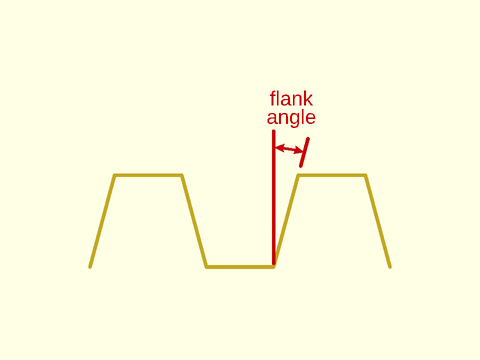
Figure 8.3.2:
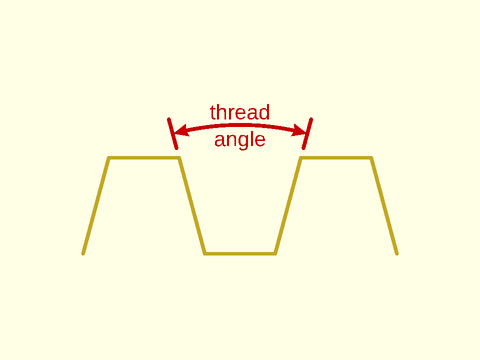
Arguments:
| By Position | What it does |
|---|---|
d |
Base diameter of threads. Default: 10 |
pitch |
Distance between threads. Default: 2 |
| By Name | What it does |
|---|---|
turns |
Number of revolutions to rotate thread around. |
thread_depth |
Depth of threads from top to bottom. |
flank_angle |
Angle of thread faces to plane perpendicular to screw. Default: 15 degrees. |
thread_angle |
Angle between two thread faces. |
profile |
If an asymmetrical thread profile is needed, it can be specified here. |
starts |
The number of thread starts. Default: 1 |
left_handed |
If true, thread has a left-handed winding. |
internal |
if true make internal threads. The only effect this has is to change how the thread lead_in is constructed. When true, the lead-in section tapers towards the outside; when false, it tapers towards the inside. Default: false |
d1 |
Bottom inside base diameter of threads. |
d2 |
Top inside base diameter of threads. |
lead_in |
Specify linear length of the lead in section of the threading with blunt start threads |
lead_in1 |
Specify linear length of the lead in section of the threading at the bottom with blunt start threads |
lead_in2 |
Specify linear length of the lead in section of the threading at the top with blunt start threads |
lead_in_ang |
Specify angular length in degrees of the lead in section of the threading with blunt start threads |
lead_in_ang1 |
Specify angular length in degrees of the lead in section of the threading at the bottom with blunt start threads |
lead_in_ang2 |
Specify angular length in degrees of the lead in section of the threading at the top with blunt start threads |
lead_in_shape |
Specify the shape of the thread lead in by giving a text string or function. Default: "sqrt" |
lead_in_sample |
Factor to increase sample rate in the lead-in section. Default: 10 |
anchor |
Translate so anchor point is at origin (0,0,0). See anchor. Default: CENTER
|
spin |
Rotate this many degrees around the Z axis after anchor. See spin. Default: 0
|
orient |
Vector to rotate top towards, after spin. See orient. Default: UP
|
Example 1: Typical Tooth Profile
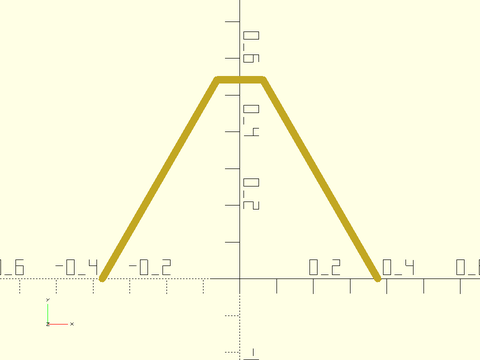
include <BOSL2/std.scad>
include <BOSL2/threading.scad>
pitch = 2;
depth = pitch * cos(30) * 5/8;
profile = [
[-6/16, 0 ],
[-1/16, depth/pitch ],
[ 1/16, depth/pitch ],
[ 6/16, 0 ],
];
stroke(profile, width=0.02);
Example 2:
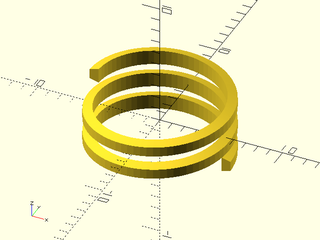
include <BOSL2/std.scad>
include <BOSL2/threading.scad>
thread_helix(d=10, pitch=2, thread_depth=0.75, flank_angle=15, turns=2.5, $fn=72);
Example 3:
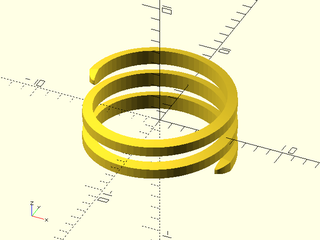
include <BOSL2/std.scad>
include <BOSL2/threading.scad>
thread_helix(d=10, pitch=2, thread_depth=0.75, flank_angle=15, turns=2.5, lead_in=1, $fn=72);
Example 4:
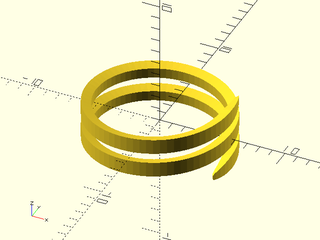
include <BOSL2/std.scad>
include <BOSL2/threading.scad>
thread_helix(d=10, pitch=2, thread_depth=0.75, flank_angle=15, turns=2, lead_in=2, internal=true, $fn=72);
Example 5:
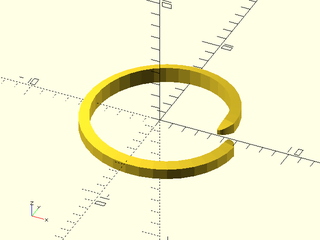
include <BOSL2/std.scad>
include <BOSL2/threading.scad>
thread_helix(d=10, pitch=2, thread_depth=0.75, flank_angle=15, turns=1, left_handed=true, lead_in=1, $fn=36);
Table of Contents
Function Index
Topics Index
Cheat Sheet
Tutorials
Basic Modeling:
- constants.scad STD
- transforms.scad STD
- attachments.scad STD
- shapes2d.scad STD
- shapes3d.scad STD
- drawing.scad STD
- masks2d.scad STD
- masks3d.scad STD
- distributors.scad STD
- color.scad STD
- partitions.scad STD
- miscellaneous.scad STD
Advanced Modeling:
- paths.scad STD
- regions.scad STD
- skin.scad STD
- vnf.scad STD
- beziers.scad STD
- nurbs.scad
- rounding.scad
- turtle3d.scad
Math:
- math.scad STD
- linalg.scad STD
- vectors.scad STD
- coords.scad STD
- geometry.scad STD
- trigonometry.scad STD
Data Management:
- version.scad STD
- comparisons.scad STD
- lists.scad STD
- utility.scad STD
- strings.scad STD
- structs.scad STD
- fnliterals.scad
Threaded Parts:
Parts:
- ball_bearings.scad
- cubetruss.scad
- gears.scad
- hinges.scad
- joiners.scad
- linear_bearings.scad
- modular_hose.scad
- nema_steppers.scad
- polyhedra.scad
- sliders.scad
- tripod_mounts.scad
- walls.scad
- wiring.scad
STD = Included in std.scad